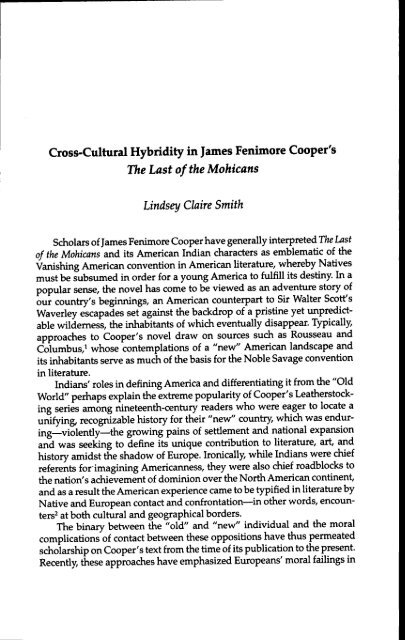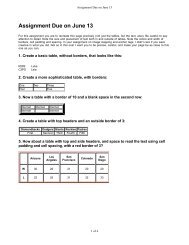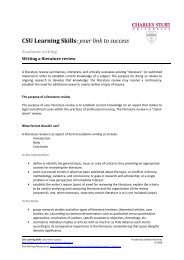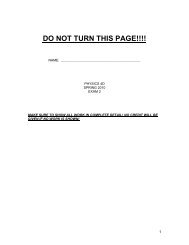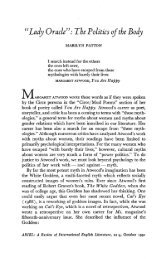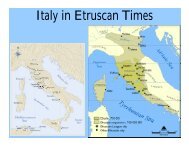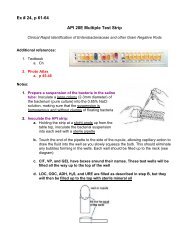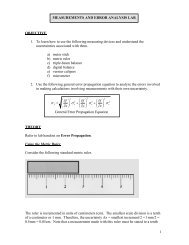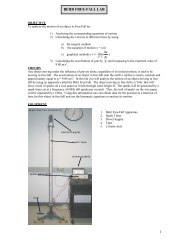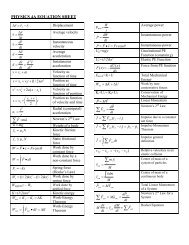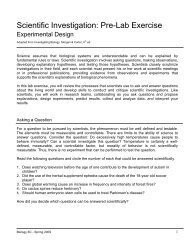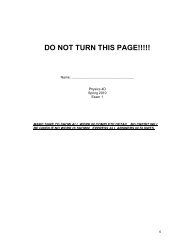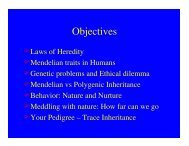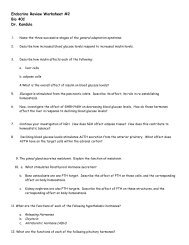Cross-Cultural Hybridity in The Last of the Mohicans
Cross-Cultural Hybridity in The Last of the Mohicans
Cross-Cultural Hybridity in The Last of the Mohicans
Create successful ePaper yourself
Turn your PDF publications into a flip-book with our unique Google optimized e-Paper software.
<strong>Cross</strong>-<strong>Cultural</strong> <strong>Hybridity</strong> <strong>in</strong> James Fenimore Cooper's<strong>The</strong> <strong>Last</strong> <strong>of</strong> <strong>the</strong> <strong>Mohicans</strong>L<strong>in</strong>dsey Claire SmithScholars <strong>of</strong> James Fenimore Cooper have generally <strong>in</strong>terpreted <strong>The</strong> <strong>Last</strong><strong>of</strong> <strong>the</strong> <strong>Mohicans</strong> and its American Indian characters as emblematic <strong>of</strong> <strong>the</strong>Vanish<strong>in</strong>g American convention <strong>in</strong> American literature, whereby Nativesmust be subsumed <strong>in</strong> order for a young America to fulfill its dest<strong>in</strong>y. In apopular sense, <strong>the</strong> novel has come to be viewed as an adventure story <strong>of</strong>our country's beg<strong>in</strong>n<strong>in</strong>gs, an American counterpart to Sir Walter Scotf sWaverley escapades set aga<strong>in</strong>st <strong>the</strong> backdrop <strong>of</strong> a prist<strong>in</strong>e yet unpredictablewilderness, <strong>the</strong> <strong>in</strong>habitants <strong>of</strong> which eventually disappear. Typically,approaches to Cooper's novel draw on sources such as Rousseau andColumbus,' whose contemplations <strong>of</strong> a "new" American landscape andits <strong>in</strong>habitants serve as mudi <strong>of</strong> <strong>the</strong> basis for <strong>the</strong> Noble Savage convention<strong>in</strong> literature.Indians' roles <strong>in</strong> def<strong>in</strong><strong>in</strong>g America and differentiat<strong>in</strong>g it from <strong>the</strong> "OldWorld" perhaps expla<strong>in</strong> <strong>the</strong> extreme popularity <strong>of</strong> Cooper's Lea<strong>the</strong>rstock<strong>in</strong>gseries among runeteenth-century readers who were eager to locate aurufy<strong>in</strong>g, recognizable history for <strong>the</strong>ir "new" country, which was endur<strong>in</strong>g—violently—<strong>the</strong>grow<strong>in</strong>g pa<strong>in</strong>s <strong>of</strong> settlement and national expansionand was seek<strong>in</strong>g to def<strong>in</strong>e its imique contribution to literature, art, andhistory amidst <strong>the</strong> shadow <strong>of</strong> Europe. Ironically, while Indians were chiefreferents for imag<strong>in</strong><strong>in</strong>g Americanness, <strong>the</strong>y were also chief roadblocks to<strong>the</strong> nation's achievement <strong>of</strong> domiruon over <strong>the</strong> North American cont<strong>in</strong>ent,and as a result <strong>the</strong> American experience came to be typified <strong>in</strong> literature byNative and European contact and corifrontation—<strong>in</strong> o<strong>the</strong>r words, encount^t bth ltl d geographical borderse pat both cultural and geographical borders.<strong>The</strong> b<strong>in</strong>ary between <strong>the</strong> "old" and "new" <strong>in</strong>dividual and <strong>the</strong> moralcomplications <strong>of</strong> contact between <strong>the</strong>se oppositions have thus permeatedscholarship on Cooper's text from <strong>the</strong> time <strong>of</strong> its publication to <strong>the</strong> present.Recently, tiiese approaches have emphasized Europeans' moral fail<strong>in</strong>gs <strong>in</strong>
<strong>Cross</strong>-<strong>Cultural</strong> <strong>Hybridity</strong> <strong>in</strong> <strong>The</strong> <strong>Last</strong> <strong>of</strong> <strong>the</strong> <strong>Mohicans</strong> 529John Locke and Sir Walter Scott <strong>in</strong>stead <strong>of</strong> <strong>in</strong>to <strong>the</strong> Fire at Onondaga, <strong>the</strong>ma<strong>in</strong>land colonial slave codes, or <strong>the</strong> rift between colonial British andAmerican policy on Indian miscegenation. Ironically, for all touted multiculturalism<strong>in</strong> academia today, <strong>the</strong>re has been surpris<strong>in</strong>gly little movement<strong>in</strong> <strong>the</strong> direction <strong>of</strong> assess<strong>in</strong>g James Fenimore Cooper as an author ahead<strong>of</strong> his time <strong>in</strong> terms <strong>of</strong> cross-cultural application. (2-3)In order to accurately assess Cooper's contribution to American literature,especially to recognize <strong>the</strong> relevance <strong>in</strong> <strong>the</strong> present day <strong>of</strong> <strong>the</strong> issues he raises<strong>in</strong> <strong>The</strong> <strong>Last</strong> <strong>of</strong> <strong>the</strong> <strong>Mohicans</strong>, a read<strong>in</strong>g <strong>of</strong> <strong>the</strong> text with particular attention to<strong>the</strong> cultural hybridity he depicts is useful.Cooper sets up <strong>the</strong> novel v^^ith several suggestions <strong>of</strong> <strong>the</strong> cultures thathave converged to create America—and <strong>the</strong> tension that convergence has<strong>in</strong>stigated. <strong>The</strong> <strong>in</strong>troduction evokes a ser\se <strong>of</strong> multiplicity among Indianpeople, referr<strong>in</strong>g to diverse tribes and tribal languages and suggest<strong>in</strong>g <strong>the</strong>possibility <strong>of</strong> Asiatic <strong>in</strong>fluences among <strong>the</strong>m. Yet Cooper acknowledges asimplistic and widespread fear <strong>of</strong> Indian "savages," which contiibuted to<strong>the</strong> popularity <strong>of</strong> narratives <strong>of</strong> captivity <strong>in</strong> <strong>the</strong> years follow<strong>in</strong>g K<strong>in</strong>g Philip'sWar and later accompanied violent campaigns aga<strong>in</strong>st American Indians.Ra<strong>the</strong>r than stok<strong>in</strong>g tiiis fear. Cooper seems somewhat to defuse it, <strong>in</strong>steadcharacteriz<strong>in</strong>g Indians' temperament as a bit more complicated:Few men exhibit greater diversity, or ... greater anti<strong>the</strong>sis <strong>of</strong> character,than <strong>the</strong> native warrior <strong>of</strong> North America. In war, he is dar<strong>in</strong>g, boastful,cunn<strong>in</strong>g, ruthless, self-deny<strong>in</strong>g, and self-devoted; <strong>in</strong> peace, just, generous,hospitable, revengeful, superstitious, modest, and commonly chaste.<strong>The</strong>se are qualities, it is true, which do not dist<strong>in</strong>guish all alike; but <strong>the</strong>yare so far <strong>the</strong> predom<strong>in</strong>at<strong>in</strong>g traits <strong>of</strong> <strong>the</strong>se remarkable people as to becharacteristic, (v)While this description is not altoge<strong>the</strong>r three-dimensional, it does attributea dynamism to American Indians that challenges <strong>the</strong> doubtfulness manyn<strong>in</strong>eteenth-century readers may have felt as to <strong>the</strong> humanity <strong>of</strong> Natives.While Cooper avoids stock <strong>in</strong>tixjduction to his Indian characters, healso avoids categorically positive or heroic characterizations <strong>of</strong> EuropeanAmericans <strong>in</strong> <strong>the</strong> beg<strong>in</strong>n<strong>in</strong>g <strong>of</strong> <strong>the</strong> novel. Instead, he describes colonists'dispositions as border<strong>in</strong>g on irrational hysteria:Numberless recent massacres were still vivid <strong>in</strong> <strong>the</strong>ir recollections; norwas <strong>the</strong>re any ear <strong>in</strong> <strong>the</strong> prov<strong>in</strong>ces so deaf as not to have drunk <strong>in</strong> withavidity <strong>the</strong> narrative <strong>of</strong> some fearful tale <strong>of</strong> midnight murder, <strong>in</strong> which<strong>the</strong> natives <strong>of</strong> <strong>the</strong> forests were <strong>the</strong> pr<strong>in</strong>cipal and barbarous actors. As<strong>the</strong> credulous and excited traveler related <strong>the</strong> hazardous chances <strong>of</strong> <strong>the</strong>wilderness, <strong>the</strong> blood <strong>of</strong> <strong>the</strong> timid curdled with terror, and mo<strong>the</strong>rs castanxious glances even at those children which slumbered with<strong>in</strong> <strong>the</strong>security <strong>of</strong> <strong>the</strong> largest towns. In short, <strong>the</strong> magnify<strong>in</strong>g <strong>in</strong>fluence <strong>of</strong> fear
530 ATQbegan to set at naught <strong>the</strong> calculations <strong>of</strong> reason, and to render thosewho should have remembered <strong>the</strong>ir manhood, <strong>the</strong> slaves <strong>of</strong> <strong>the</strong> basest<strong>of</strong> passions. (14)Cooper relays volatility <strong>in</strong> <strong>the</strong> sett<strong>in</strong>g <strong>of</strong> his narrative, which heightens amood <strong>of</strong> suspended action and excitement, yet he also provides a basisfor <strong>the</strong> human considerations that will accompany his adventure tale. AsJohn McWilliams reveals, "For <strong>the</strong> casual n<strong>in</strong>eteenth-century reader. Cooperpla<strong>in</strong>ly knew how to tum racial fear <strong>in</strong>to a gripp<strong>in</strong>g read" (16). Amidunstable borders, <strong>the</strong> characters (and readers) are forced to confront those<strong>the</strong>y perceive to be <strong>the</strong>ir opposition, and <strong>in</strong> <strong>the</strong> process <strong>the</strong>y have <strong>the</strong> opportunityto be transformed.Cooper portrays this cultural reciprocity <strong>in</strong> scenes <strong>in</strong> which Indian andwhite characters discuss <strong>the</strong>ir cultural orig<strong>in</strong>s <strong>in</strong> <strong>the</strong> American landscapeand relate <strong>the</strong>m to <strong>the</strong> broader discussion <strong>of</strong> <strong>the</strong> development <strong>of</strong> a nation.Early <strong>in</strong> <strong>the</strong> novel, Bumppo and Ch<strong>in</strong>gachgook compare stories <strong>of</strong> how<strong>the</strong>ir people came to <strong>in</strong>habit <strong>the</strong>ir current geographical space. Referenc<strong>in</strong>g<strong>the</strong> moral questions surround<strong>in</strong>g European entry <strong>in</strong>to <strong>the</strong> area, Bumppo,speak<strong>in</strong>g <strong>in</strong> a Native language, simply makes <strong>the</strong> orig<strong>in</strong>ary stories parallel,assert<strong>in</strong>g: "'Your fa<strong>the</strong>rs came from <strong>the</strong> sett<strong>in</strong>g sun, crossed <strong>the</strong> big river,fought <strong>the</strong> people <strong>of</strong> <strong>the</strong> covmtry, and took <strong>the</strong> land; and m<strong>in</strong>e came from<strong>the</strong> red sky <strong>of</strong> <strong>the</strong> morn<strong>in</strong>g, over <strong>the</strong> salt lake, and did <strong>the</strong>ir work muchafter <strong>the</strong> fashion that had been set <strong>the</strong>m by yours; <strong>the</strong>n let God judge <strong>the</strong>matter between us, and friends spare <strong>the</strong>ir words!'" (34). Bumppo cont<strong>in</strong>ueswith an evaluation <strong>of</strong> his European ancestry, disparag<strong>in</strong>g whites' tradition<strong>of</strong> depend<strong>in</strong>g upon pr<strong>in</strong>t to convey <strong>the</strong>ir experiences yet venerat<strong>in</strong>g <strong>the</strong>Bumppos for <strong>the</strong>ir skill at shoot<strong>in</strong>g.Bumppo <strong>the</strong>n asks Ch<strong>in</strong>gachgook about his ancestors:"'... every storyhas its two sides: so I ask you, Ch<strong>in</strong>gachgook, what passed, accord<strong>in</strong>g to <strong>the</strong>traditions <strong>of</strong> <strong>the</strong> Red Men, when our fa<strong>the</strong>rs firstmet?'" (35). Ch<strong>in</strong>gachgook,after relay<strong>in</strong>g an emergence narrative <strong>of</strong> his people's journey across <strong>the</strong> pla<strong>in</strong>sto his current dwell<strong>in</strong>g, tells, with some emotion, <strong>of</strong> <strong>the</strong> <strong>Mohicans</strong>' thriv<strong>in</strong>gculture at <strong>the</strong> time <strong>of</strong> contact with whites:"'... we were one people, and wewere happy. <strong>The</strong> salt lake gave us its fish, <strong>the</strong> wood its deer, and <strong>the</strong> air itsbirds. We took wives who bore us children; we worshiped <strong>the</strong> Great Spirit;and we kept <strong>the</strong> Maquas beyond <strong>the</strong> sound <strong>of</strong> our songs <strong>of</strong> triumph!'" (37).Ch<strong>in</strong>gachgook <strong>the</strong>n describes <strong>the</strong> effect <strong>of</strong> contact:"<strong>The</strong> Dutch landed, and gave my people <strong>the</strong> firewater; <strong>the</strong>y drank imtil<strong>the</strong> heavens and <strong>the</strong> earth seemed to meet, and <strong>the</strong>y foolishly thought<strong>the</strong>y had found <strong>the</strong> Great Spirit. <strong>The</strong>n <strong>the</strong>y parted with <strong>the</strong>ir land. Footby foot, <strong>the</strong>y were driven back from <strong>the</strong> shores, until I, that am a chiefand a Sagamore, have never seen <strong>the</strong> sun sh<strong>in</strong>e but through <strong>the</strong> trees,and have never visited <strong>the</strong> graves <strong>of</strong> my fa<strong>the</strong>rs!" (37-38)
532 ATQDutch. He is particularly saddened because he has never seen <strong>the</strong> sun ashis ancestors did, and he has never visited <strong>the</strong> land where <strong>the</strong>y are buried.In effect, he is removed from his "Native space." Similarly, he articulateshis lack <strong>of</strong> hope for <strong>the</strong> future <strong>in</strong> ecological terms, <strong>of</strong> geographical dislocation:"'Where are <strong>the</strong> blossoms <strong>of</strong> those summers! Fallea one by one. Soall <strong>of</strong> my family departed, each <strong>in</strong> his turn, to <strong>the</strong> land <strong>of</strong> spirits. I am on<strong>the</strong> hilltop, and must go down <strong>in</strong>to <strong>the</strong> valley; and when Uncas follows <strong>in</strong>my footsteps, <strong>the</strong>re will no longer be any <strong>of</strong> <strong>the</strong> blood <strong>of</strong> <strong>the</strong> Sagamores,for my boy is <strong>the</strong> last <strong>of</strong> <strong>the</strong> <strong>Mohicans</strong>'" (38).Like Ch<strong>in</strong>gachgook, Bumppo also seeks to locate a sense <strong>of</strong> identityby connect<strong>in</strong>g to <strong>the</strong> natural world, and when that world is altered, hetoo expresses ambivalence. One <strong>of</strong> <strong>the</strong> most poignant <strong>in</strong>stances <strong>in</strong> whichBumppo conceptualizes his self <strong>in</strong> terms <strong>of</strong> ecological phenomena occurs<strong>in</strong> his description <strong>of</strong> Glenn's Falls:"[T]he falls have nei<strong>the</strong>r shape nor consistency.... If you had daylight,it would be worth <strong>the</strong> trouble to step up on <strong>the</strong> height <strong>of</strong> this rock, andlook at <strong>the</strong> perversity <strong>of</strong> <strong>the</strong> water. It falls by no rule at all; sometimes itleaps, sometimes it tumbles; <strong>the</strong>re, it skips; here, it shoots; <strong>in</strong> one place'tis white as snow, and <strong>in</strong> ano<strong>the</strong>r 'tis green as grass; hereabouts, it pitches<strong>in</strong>to deep hollows, that rumble and quake die 'arth; and <strong>the</strong>reaway, itripples and s<strong>in</strong>gs like a brook, fashion<strong>in</strong>g whirlpools and guUeys <strong>in</strong> <strong>the</strong>old stone, as if 'twas no harder than trodden day. <strong>The</strong> whole design <strong>of</strong><strong>the</strong> river seems disconcerted. First it runs smoothly, as if mean<strong>in</strong>g to godown <strong>the</strong> descent as th<strong>in</strong>gs were ordered; <strong>the</strong>n it angles about and faces<strong>the</strong> shores; nor are <strong>the</strong>re places want<strong>in</strong>g where it looks backward, as ifunwill<strong>in</strong>g to leave <strong>the</strong> wilderness, to m<strong>in</strong>gle with <strong>the</strong> salt!... After <strong>the</strong>water has been suffered to have its will, for a time, like a headstrong man,it is ga<strong>the</strong>red toge<strong>the</strong>r by <strong>the</strong> hand that made it, and a few rods below youmay see it all, flow<strong>in</strong>g on steadily toward <strong>the</strong> sea, as was foreorda<strong>in</strong>edfrom <strong>the</strong> first foundation <strong>of</strong> <strong>the</strong> 'arth!" (63-64)In this episode. Cooper captures <strong>the</strong> complex confrontation <strong>of</strong> peoples, <strong>the</strong>irorig<strong>in</strong>s, and cultures, that typifies <strong>the</strong> historical moment <strong>in</strong> which Bumpp<strong>of</strong><strong>in</strong>ds himself. Just as <strong>the</strong> falls seem disconcerted, lack<strong>in</strong>g rule, and at timeshesitant to converge on <strong>the</strong>ir way to a vast sea, so too various groups <strong>in</strong>America are experienc<strong>in</strong>g tension and violence <strong>in</strong> <strong>the</strong>ir encounters with oneano<strong>the</strong>r on <strong>the</strong>ir way to a common pla<strong>in</strong>, which refiects a multi-faceted yetoverarch<strong>in</strong>g syn<strong>the</strong>sis.Similar to Ch<strong>in</strong>gachgook's description <strong>of</strong> his existence before <strong>the</strong> arrival<strong>of</strong> <strong>the</strong> Dutch, Bumppo seems to remember a time when <strong>the</strong> falls wereundivided and undisturbed. In this self-referential formulation, he likens<strong>the</strong> falls to a confiicted man, which clearly alludes to his own conflictedidentity as one bound to his American Indian comrades yet also def<strong>in</strong>ed<strong>in</strong> part by his European orig<strong>in</strong>. And also like Ch<strong>in</strong>gachgook, at <strong>the</strong> end <strong>of</strong>
<strong>Cross</strong>-<strong>Cultural</strong> <strong>Hybridity</strong> <strong>in</strong> <strong>The</strong> <strong>Last</strong> <strong>of</strong> <strong>the</strong> <strong>Mohicans</strong> 533<strong>the</strong> novel, Bumppo is compelled by a tremendous sense <strong>of</strong> loss as a result<strong>of</strong> <strong>the</strong> fad<strong>in</strong>g presence <strong>of</strong> his people: his European travel<strong>in</strong>g companions aswell as his fellow dwellers <strong>of</strong> <strong>the</strong> woods. Importantly, his cormection to aparticular geographical space strongly compels him: "Hawk-eye returnedto <strong>the</strong> spot where his own sympathies led him, with a force that no idealbond <strong>of</strong> union could bestow. He was just <strong>in</strong> time to catch a part<strong>in</strong>g look <strong>of</strong><strong>the</strong> features <strong>of</strong> Uncas, whom <strong>the</strong> Delawares were already <strong>in</strong>clos<strong>in</strong>g <strong>in</strong> hislast vestments <strong>of</strong> sk<strong>in</strong>s" (413). For Bumppo, who encompasses a hybrididentity, <strong>the</strong> location <strong>in</strong> <strong>the</strong> forest <strong>of</strong> contact among varied peoples is <strong>the</strong>most appropriate place to cont<strong>in</strong>ue to live out his existence.In <strong>the</strong> same way that <strong>the</strong>se locations <strong>of</strong> contact, or ecological spaces,correspond to Ch<strong>in</strong>gachgook's and Bumppo's senses <strong>of</strong> personal ancestryand identity, <strong>the</strong>se zones also exhibit a synergy with <strong>the</strong> events <strong>in</strong> <strong>the</strong> novelthat b<strong>in</strong>d <strong>the</strong>m and o<strong>the</strong>r characters toge<strong>the</strong>r <strong>in</strong> a narrative <strong>of</strong> cross-culturalcontact <strong>in</strong> early America. This l<strong>in</strong>k<strong>in</strong>g <strong>of</strong> ecology and human orig<strong>in</strong>ary actionreflects David Mazel's understand<strong>in</strong>g <strong>of</strong> environmentalism as a morecomplicated discipl<strong>in</strong>e than a philosophy that mirrors domestic Orientalism,or an approach to nature as "a self-evidently pure and 'good' resistance toan external and 'bad' force" ("American" 43). Draw<strong>in</strong>g on <strong>the</strong> lessons <strong>of</strong>Edward Said's framework, Mazel argues for an analysis <strong>of</strong> environmentas "just one <strong>of</strong> many potential modes for exercis<strong>in</strong>g power, as a particular'style,' both political and epistemological, 'for dom<strong>in</strong>at<strong>in</strong>g, restructur<strong>in</strong>g,and hav<strong>in</strong>g authority' over <strong>the</strong> real territories and lives that <strong>the</strong> environmentdisplaces and for which it is <strong>in</strong>voked as a representation" (43). In this read<strong>in</strong>g,<strong>in</strong> Cooper's novel, <strong>the</strong> natural world is more than a passive abstractionto be corifronted; <strong>in</strong>stead, it is an agent that is present <strong>in</strong> human actions.<strong>The</strong> environment's participatory role is evident perhaps most strik<strong>in</strong>gly<strong>in</strong> scenes <strong>of</strong> violence and apparent degradation that heighten <strong>the</strong> pl<strong>of</strong> ssuspense. One such scene occurs when David Gamut's colt is killed beforeBumppo, Ch<strong>in</strong>gachgook, and <strong>the</strong>ir fellow travelers become entangled <strong>in</strong> <strong>the</strong>many bloody battles that will typify <strong>the</strong>ir journey toge<strong>the</strong>r. Though Gamutbegs for <strong>the</strong> creature's life, Bumppo <strong>in</strong>sists that circumstances necessitate<strong>the</strong> sacrifice <strong>of</strong> <strong>the</strong> <strong>in</strong>nocent and <strong>in</strong>structs Uncas to br<strong>in</strong>g a quick end to<strong>the</strong> foal. This scene sets <strong>the</strong> stage for <strong>the</strong> <strong>in</strong>discrim<strong>in</strong>ate destruction <strong>of</strong> awoman and her <strong>in</strong>fant at <strong>the</strong> massacre after <strong>the</strong> surrender <strong>of</strong> Fort WilliamHenry, where nature itself seems to encompass <strong>the</strong> devastation wroughtby human conflict.After Indian allies <strong>of</strong> <strong>the</strong> French slaughter retreat<strong>in</strong>g English, <strong>the</strong> landscapeat <strong>the</strong> fort, flow<strong>in</strong>g with rivers <strong>of</strong> blood and dotted with <strong>the</strong> bodies <strong>of</strong><strong>the</strong> dead, captures <strong>the</strong> harsh but <strong>in</strong>tr<strong>in</strong>sic nature <strong>of</strong> humanity. This humanexistence is marked by both violence and survival:
534 ATQ[H)ere and <strong>the</strong>re, a dark green tuft rose <strong>in</strong> <strong>the</strong> midst <strong>of</strong> <strong>the</strong> desolation; <strong>the</strong>earliest fruits<strong>of</strong> a soil that had been fattened with human blood. <strong>The</strong> wholelandscape, which seen by a favor<strong>in</strong>g light, and <strong>in</strong> a genial temperature,had been found so lovely, appeared now like some pictured allegory <strong>of</strong>life, <strong>in</strong> which objects were arrayed <strong>in</strong> <strong>the</strong>ir harshest but truest colors.(213-14)<strong>The</strong>se scenes, and <strong>the</strong> environments that enact <strong>the</strong>m, lay out <strong>the</strong> bare andsometimes ugly truth <strong>of</strong> human actions, especially with<strong>in</strong> <strong>the</strong> context <strong>of</strong>contact across varied cultures. As Shirley Samuels has shown, "<strong>the</strong>se kill<strong>in</strong>gsconflate domestic and wild, suggest<strong>in</strong>g <strong>the</strong> conflation <strong>of</strong> animals andhumans throughout <strong>the</strong> novel" (87), and ultimately, "frontier transactions<strong>in</strong>volv<strong>in</strong>g animals and humans produce a radically crossed or miscegenatedidentity, produc<strong>in</strong>g, <strong>in</strong> effect, a miscegenation between nature andculture" (89).This conflation <strong>of</strong> features <strong>of</strong> <strong>the</strong> natural world with <strong>the</strong> processes <strong>of</strong>human cultures <strong>in</strong> contact is also evident at <strong>the</strong> end <strong>of</strong> <strong>the</strong> novel whenalmost all <strong>of</strong> <strong>the</strong> ma<strong>in</strong> characters don disguises <strong>of</strong> nature, <strong>in</strong>clud<strong>in</strong>g animalisticcostumes, <strong>in</strong> order to rescue Alice and Cora from <strong>the</strong>ir Huron andDelaware captors. As Betty Becker-<strong>The</strong>ye po<strong>in</strong>ts out, <strong>the</strong>se humans <strong>in</strong>animal disguise, ak<strong>in</strong> to <strong>the</strong> murdered <strong>in</strong>fant who is represented by <strong>the</strong>helpless colt, are virtually <strong>the</strong> only animals present <strong>in</strong> <strong>the</strong> novel, mak<strong>in</strong>g<strong>the</strong> human/environment bond all <strong>the</strong> more po<strong>in</strong>ted <strong>in</strong> <strong>the</strong> transmission<strong>of</strong> <strong>the</strong> plot (48). This donn<strong>in</strong>g <strong>of</strong> elements <strong>of</strong> <strong>the</strong> natural world first occurswhen Ch<strong>in</strong>gachgook, who is skilled at "tak[<strong>in</strong>g] down natur' on scraps <strong>of</strong>paper" (270), makes a "natural fool" (271) <strong>of</strong> Duncan Heyward, us<strong>in</strong>g keysymbols <strong>of</strong> nature to pa<strong>in</strong>t on him <strong>the</strong> disgtiise <strong>of</strong> a juggler, a healer whotags along with tribal allies <strong>of</strong> <strong>the</strong> Hurons, an identity far removed fromhis stature as a major <strong>in</strong> <strong>the</strong> English military.Through this disguise and his use <strong>of</strong> French, Duncan is able to enter<strong>the</strong> company <strong>of</strong> <strong>the</strong> Hurons, who he acknowledges have "an <strong>in</strong>st<strong>in</strong>ct nearlycommensurate with his own reason" (272) and proceed to <strong>the</strong> location whereMagua is hold<strong>in</strong>g Alice captive. Before enter<strong>in</strong>g <strong>the</strong> cave, at Bumppo's<strong>in</strong>struction, Heyward washes away <strong>the</strong> pa<strong>in</strong>t <strong>in</strong> order to approach Alice<strong>in</strong> a pale-faced state that Bumppo believes a white daughter <strong>of</strong> a colonelexpects. However, <strong>in</strong> order for Heyward to remove her to safety, he mustdisguise Alice <strong>in</strong> <strong>the</strong> clo<strong>the</strong>s <strong>of</strong> an Indian woman, <strong>the</strong>reby cont<strong>in</strong>u<strong>in</strong>g to,<strong>in</strong> Samuels's words, "trouble <strong>the</strong> presumed <strong>in</strong>tegrity" (99) <strong>of</strong> Europeanidentity <strong>in</strong> order to ensure survival.Hawkeye, Gamut, and Uncas are also critical to this rescue scene, as<strong>the</strong>ir assumption <strong>of</strong> animal disguises fur<strong>the</strong>r enables <strong>the</strong>m and <strong>the</strong>ir friendsto escape <strong>the</strong> Huron camp. After Uncas is captured, Hawkeye enters <strong>the</strong>camp disguised as a bear and attempts to signal his presence to Gamut
<strong>Cross</strong>-<strong>Cultural</strong> <strong>Hybridity</strong> <strong>in</strong> <strong>The</strong> <strong>Last</strong> <strong>of</strong> <strong>the</strong> <strong>Mohicans</strong> 535by s<strong>in</strong>g<strong>in</strong>g. Confused and a little afraid. Gamut exclaims to Heyward thatAlice is expect<strong>in</strong>g him, which spurs Heyward's enactment <strong>of</strong> his escapeplan. Hawkeye enters <strong>the</strong> cave and frightens Magua, allow<strong>in</strong>g Heyward totie him up and escape with Alice. Still <strong>in</strong> <strong>the</strong> guise <strong>of</strong> a bear, Hawkeye goesto <strong>the</strong> hut where Gamut, still mentally shaken about <strong>the</strong> seem<strong>in</strong>gly humannature <strong>of</strong> <strong>the</strong> bear, has covered his bald head with a "triangular beaver"(317). After Hawkeye reveals himself to Gamut, <strong>the</strong> two enter <strong>the</strong> hut whereUncas is imprisoned, and <strong>the</strong>re, <strong>the</strong> three men swap dress: Uncas wear<strong>in</strong>g<strong>the</strong> bear sk<strong>in</strong>, Hawkeye wear<strong>in</strong>g <strong>the</strong> clo<strong>the</strong>s <strong>of</strong> Gamut, and Gamut wear<strong>in</strong>gHawkeye's hunt<strong>in</strong>g shirt <strong>in</strong> order to rema<strong>in</strong> and impersonate Uncas.This exchange signifies a breakdown <strong>in</strong> demarcations <strong>of</strong> race and <strong>of</strong>components <strong>of</strong> <strong>the</strong> natural world that are perceived to be rigid. As Mazelconcludes, toward its end, <strong>the</strong> novel moves <strong>in</strong>to a "fluidity <strong>of</strong> performance—suggest<strong>in</strong>gthat nature is not 'natural' at all but performative. ... <strong>the</strong>re looms also a sense <strong>of</strong> category crisis, <strong>of</strong> a breakdown <strong>in</strong> <strong>the</strong> verystructures by means <strong>of</strong> which nature and culttire have been demarcated <strong>in</strong><strong>the</strong> first place" ("Perform<strong>in</strong>g" 108). This "category crisis," or <strong>in</strong>stability <strong>of</strong>social, natural, and cultural boundaries, accompanies unstable identity formany <strong>of</strong> <strong>the</strong> major characters, who without rigid boimdaries, renegotiate<strong>the</strong>ir understand<strong>in</strong>gs <strong>of</strong> both <strong>the</strong>ir relations to one ano<strong>the</strong>r and <strong>the</strong>ir ownsenses <strong>of</strong> self. Similarly, Samuels argues that <strong>the</strong>se disguises are merelyone reflection <strong>of</strong> <strong>the</strong> way <strong>in</strong> which <strong>the</strong> novel cont<strong>in</strong>ually complicates rigidclassifications <strong>of</strong> identity, emphasiz<strong>in</strong>g "collisions and corifusions" (98).More extensive evidence <strong>of</strong> <strong>the</strong> way <strong>in</strong> which this meet<strong>in</strong>g <strong>of</strong> oster\siblydisparate cultures produces more endur<strong>in</strong>g consequences occurs <strong>in</strong> <strong>the</strong>temperaments and behaviors <strong>of</strong> <strong>the</strong> characters <strong>the</strong>mselves, especially <strong>the</strong>characters' relationships to one ano<strong>the</strong>r. While Fiedler has made much <strong>of</strong><strong>the</strong> "doubl<strong>in</strong>g" <strong>of</strong> opposite characters <strong>in</strong> <strong>the</strong> novel—dark-sk<strong>in</strong>ned versuswhite, savage versus civilized, pagan versus Christian —most <strong>of</strong> <strong>the</strong> characters<strong>in</strong> fact display some k<strong>in</strong>d <strong>of</strong> mediation or modification as a result<strong>of</strong> <strong>the</strong>ir experiences <strong>in</strong> <strong>the</strong> woods with representatives <strong>of</strong> o<strong>the</strong>r cultures,display<strong>in</strong>g what anthropologist A. Irv<strong>in</strong>g Hallowell calls "transculturalization,"whereby <strong>in</strong>dividuals "enter <strong>the</strong> web <strong>of</strong> social relations that constituteano<strong>the</strong>r society, and come under <strong>the</strong> <strong>in</strong>fluence <strong>of</strong> its customs, ideas, andvalues to a greater or lesser degree" (523).While much has been written about <strong>the</strong> "savage nobility" <strong>of</strong> Cooper'sAmerican Indian characters, <strong>in</strong>clud<strong>in</strong>g Uncas and Ch<strong>in</strong>gachgook, mostcritics are content to understand Magua as simply savage. Whe<strong>the</strong>r <strong>the</strong>yattribute this savage characterization to Cooper's failure to portray effectiveliterary characters or to racism aga<strong>in</strong>st American Indians, <strong>the</strong>se critics failto evaluate Magua with<strong>in</strong> <strong>the</strong> context <strong>of</strong> cultural collision <strong>in</strong> Cooper's text,a context which places him squarely at <strong>the</strong> crossroads <strong>of</strong> various tribal and
536 ATQcolonial alliances dur<strong>in</strong>g a time <strong>of</strong> war. Relegat<strong>in</strong>g him to a "bad Indian"camp, many fail to perceive <strong>the</strong> diverse <strong>in</strong>fluences and experiences that havemade Magua <strong>the</strong> more <strong>in</strong>terest<strong>in</strong>g tragic villa<strong>in</strong> that he is. Qeverly, Cooperdraws Magua <strong>in</strong> a way that plays <strong>in</strong>to <strong>the</strong> fears <strong>of</strong> n<strong>in</strong>eteenth-century whitereaders, yet he also projects readers' fears onto a character whose quest forrevenge is largely due to <strong>the</strong> harmful actions <strong>of</strong> European settlers.Magua's description <strong>of</strong> <strong>the</strong> history beh<strong>in</strong>d his arrival as a Mohawkwarrior reveals <strong>the</strong> degree to which European <strong>in</strong>filtration has contributedto his present state. He expla<strong>in</strong>s to Cora:"Magua was bom a chief and a warrior among <strong>the</strong> red Hurons <strong>of</strong> <strong>the</strong> lakes;he saw <strong>the</strong> suns <strong>of</strong> twenty summers make <strong>the</strong> snows <strong>of</strong> twenty w<strong>in</strong>tersrun <strong>of</strong>f <strong>in</strong> <strong>the</strong> streams, before he saw a paleface; and he was happy! <strong>The</strong>nhis Canada fa<strong>the</strong>rs came <strong>in</strong>to <strong>the</strong> woods and taught him to dr<strong>in</strong>k <strong>the</strong>firewater, and he became a rascal. <strong>The</strong> Hurons drove him from <strong>the</strong> graves<strong>of</strong> his fa<strong>the</strong>rs as <strong>the</strong>y would chase <strong>the</strong> hunted buffalo. He ran down <strong>the</strong>shores <strong>of</strong> <strong>the</strong> lakes, and followed <strong>the</strong>ir outlet to <strong>the</strong> dty <strong>of</strong> carmon. <strong>The</strong>rehe hunted and fished,till <strong>the</strong> people chased him aga<strong>in</strong> through <strong>the</strong> woods<strong>in</strong>to <strong>the</strong> arms <strong>of</strong> his enemies. <strong>The</strong> chief, who was bom a Huron, was atlast a warrior among <strong>the</strong> Mohawks!" (119-20)This narrative, which H. Daruel Peck calls "<strong>the</strong> novel's most compell<strong>in</strong>gelegiac vision <strong>of</strong> Indian dispossession" (9) is remarkably similar toCh<strong>in</strong>gachgook's description <strong>of</strong> his own people's dispossession and hisparticular sadness at be<strong>in</strong>g separated from <strong>the</strong> graves <strong>of</strong> his ancestors. <strong>The</strong>similarity begs <strong>the</strong> question: Why do Magua and Ch<strong>in</strong>gachgook end upso remarkably different?<strong>The</strong> answer seems to lie <strong>in</strong> Magua's "becom<strong>in</strong>g a rascal," neglect<strong>in</strong>g <strong>the</strong>values <strong>of</strong> his people and becom<strong>in</strong>g subject to <strong>the</strong> <strong>in</strong>fluence <strong>of</strong> those who wantto use him, especially French commanders allied with <strong>the</strong> Mohawks. <strong>The</strong>difference <strong>in</strong> <strong>the</strong> two characters' animalistic names reveals much about <strong>the</strong>irnatures. Accord<strong>in</strong>g to Hawkeye, Ch<strong>in</strong>gachgook, whose <strong>in</strong>digenous namemeans "big serpent" <strong>in</strong> English, "'understands <strong>the</strong> w<strong>in</strong>d<strong>in</strong>g and turn<strong>in</strong>gs<strong>of</strong> human natur"" (67), which perhaps expla<strong>in</strong>s why, even though he hasaided Heyward and Munro and developed a pr<strong>of</strong>ound bond with Hawkeye,he has none<strong>the</strong>less endured as a valiant Mohican. In contrast, Maguastruggles with <strong>the</strong> Delaware language and refers to himself <strong>in</strong> French as"Le Renard Subtil," or "<strong>The</strong> Subtle Fox," <strong>the</strong> name given to him by his "Canadianfa<strong>the</strong>rs," a designation that emphasizes Europeans' approximation<strong>of</strong> him, an identity that he has <strong>in</strong>ternalized. In this way, Magua's betrayal<strong>of</strong> Heyward <strong>in</strong> <strong>the</strong> beg<strong>in</strong>n<strong>in</strong>g <strong>of</strong> <strong>the</strong> novel, when he <strong>in</strong>tends to lead himand <strong>the</strong> Munro daughters <strong>in</strong>to a trap, as well as his <strong>in</strong>sistence on exact<strong>in</strong>grevenge on Munro by tak<strong>in</strong>g one <strong>of</strong> his pale-faced daughters as a wife, isright <strong>in</strong> l<strong>in</strong>e with this Frendi colonial affiliation. Magua's actions mirror
<strong>Cross</strong>-<strong>Cultural</strong> <strong>Hybridity</strong> <strong>in</strong> <strong>The</strong> <strong>Last</strong> <strong>of</strong> <strong>the</strong> <strong>Mohicans</strong> 537Montcalm's violation <strong>of</strong> his terms <strong>of</strong> surrender with Muru'o, a surrenderwhich features a slaughter <strong>of</strong> irmocents while <strong>the</strong> English are <strong>in</strong> retreat toFort Edward. Unlike Ch<strong>in</strong>gachgook, whose body is drawn clearly <strong>in</strong> "<strong>in</strong>term<strong>in</strong>gledcolors <strong>of</strong> white and black" (32), Magua's face reflects <strong>the</strong> degreeto which his alliances have transformed him: "<strong>The</strong> colors <strong>of</strong> <strong>the</strong> war pa<strong>in</strong>thad blended <strong>in</strong> dark confusion about his fierce countenance" (20).Importantly, Magua is <strong>the</strong>reby not as <strong>in</strong>human as many readers, andsome critics, expect him to be, and moreover, what makes Magua so <strong>in</strong>terest<strong>in</strong>gis <strong>the</strong> degree to which he recognizes <strong>the</strong> corruption <strong>of</strong> <strong>the</strong> people withwhom he has corisorted. At <strong>the</strong> end <strong>of</strong> <strong>the</strong> novel, <strong>in</strong> his appeal to Tamenundfor <strong>the</strong> retum <strong>of</strong> his escaped prisoners, Magua portrays <strong>the</strong> white man asmost cunn<strong>in</strong>g: "'With his tongue, he stops <strong>the</strong> ears <strong>of</strong> <strong>the</strong> Indians; his heartteaches him to pay warriors to fight his battles; his cunn<strong>in</strong>g tells him howto get toge<strong>the</strong>r <strong>the</strong> goods <strong>of</strong> <strong>the</strong> earth; and his arms <strong>in</strong>close <strong>the</strong> land from<strong>the</strong> shores <strong>of</strong> <strong>the</strong> salt water to <strong>the</strong> islands <strong>of</strong> <strong>the</strong> great lake. His gluttonymakes him sick. God gave him enough, and yet he wants all'" (356-57).Magua places <strong>the</strong> blame on his weakness for alcohol, through which hestrayed from his people and for which Munro has publicly "'whipped himlike a dog'" (120), squarely with colorual <strong>in</strong>vaders: "'Was it <strong>the</strong> fault <strong>of</strong> LeRenard that his head was not made <strong>of</strong> rock? Who gave him <strong>the</strong> firewater?Who made him a villa<strong>in</strong>?'" (120). Indeed, it may be Magua's refusal to seehis own agency <strong>in</strong> his fate that is his tragic flaw, a complexity <strong>of</strong> characterthat makes him quite compell<strong>in</strong>g.Like Magua, Cora exhibits a plurality <strong>of</strong> affiliation, but whereas Magua'spersonal weakness leads to villa<strong>in</strong>y with<strong>in</strong> this context <strong>of</strong> transculturalization,Cora's moral fortitude makes her <strong>the</strong> novel's hero<strong>in</strong>e. As <strong>the</strong> child <strong>of</strong>Colonel Munro and a woman descended from Africans enslaved <strong>in</strong> <strong>the</strong> WestIndies, Cora is portrayed as <strong>of</strong> mixed ancestry, an embodiment <strong>of</strong> her fa<strong>the</strong>r'scross-racial union. Cora's diverse backgroimd dist<strong>in</strong>guishes her from herpurely Scottish sister Alice, and <strong>the</strong> two provide a commentary on fem<strong>in</strong><strong>in</strong>ity<strong>in</strong> an American space separate from <strong>the</strong> f<strong>in</strong>eries <strong>of</strong> Europe. While Alice istimid and easily frightened <strong>in</strong>to fa<strong>in</strong>ts, Cora is passionate, <strong>in</strong>dependent, andbrave, rem<strong>in</strong>iscent<strong>of</strong> o<strong>the</strong>r hero<strong>in</strong>es <strong>of</strong> popular n<strong>in</strong>eteenth-centuryfiction yetunique <strong>in</strong> her effectiveness <strong>in</strong> a wilderness sett<strong>in</strong>g outside <strong>of</strong> <strong>the</strong> domesticsphere. Her appearance is likewise unique: "<strong>The</strong> tresses <strong>of</strong> this lady weresh<strong>in</strong><strong>in</strong>g and black, like <strong>the</strong> plumage <strong>of</strong> <strong>the</strong> raven. Her complexion was notbrown, but it ra<strong>the</strong>r appeared charged with <strong>the</strong> color <strong>of</strong> <strong>the</strong> rich blood, thatseemed ready to burst its boimds. And yet <strong>the</strong>re was nei<strong>the</strong>r coarsenessnor want <strong>of</strong> shadow<strong>in</strong>g <strong>in</strong> a countenance that was exquisitely regular anddigrufied, and svirpass<strong>in</strong>gly beautiful" (21). Cora's matchless attributes,<strong>in</strong>clud<strong>in</strong>g her determ<strong>in</strong>ation to protect her sister, prepare her for <strong>the</strong> trialsshe endures. As McWilliams expla<strong>in</strong>s, "To all characters who vmderstand
538 ATQ<strong>the</strong> forest, Cora seems a significant human be<strong>in</strong>g but Alice rema<strong>in</strong>s at besta tender blossom" (73).N<strong>in</strong>a Baym has written extensively <strong>of</strong> <strong>the</strong> contrast between Alice andCora, emphasiz<strong>in</strong>g <strong>the</strong> appropriateness <strong>of</strong> Alice's <strong>in</strong>effectual behavior <strong>in</strong> amale-dom<strong>in</strong>ated white world. Baym believes that this behavior ultimatelysaves Alice: "A woman's weakness is her strength <strong>in</strong> <strong>the</strong> white world, becauseit <strong>in</strong>spires men like Dxmcan, representative <strong>of</strong> European-Americancivilization, to fight for her" {77). Baym is correct that Alice is <strong>the</strong> moreappropriate matdi for Duncan <strong>in</strong> <strong>the</strong> white world, especially because, asBarbara Mann rem<strong>in</strong>ds us, imder colonial law, Cora would have been classifiedas a slave <strong>in</strong> that world (51). However, Alice is not <strong>the</strong> only characterfor whom Heyward and o<strong>the</strong>rs risk <strong>the</strong>ir lives; Cooper has gone to greatlengths to craft an elaborate and dangerous cooperative escape plot, completewith costumes, for <strong>the</strong> survival <strong>of</strong> almost all <strong>of</strong> <strong>the</strong> ma<strong>in</strong> characters,and later <strong>in</strong> <strong>the</strong> novel, Uncas leads an entire Delaware nation, as well asHawkeye, Gamut, and Heyward, <strong>in</strong>to war aga<strong>in</strong>st Magua and <strong>the</strong> Huronson Cora's behalf.More importantly, while Alice does not embody <strong>the</strong> strength <strong>of</strong> Cora,she is not quite <strong>the</strong> shr<strong>in</strong>k<strong>in</strong>g fiower that many critics have perceived herto be, and she does exhibit <strong>in</strong>sight and bravery at crucial moments. It is because<strong>of</strong> Alice that Gamut, who later contributes to <strong>the</strong> success <strong>of</strong> <strong>the</strong> escapeplan, is <strong>in</strong>cluded among <strong>the</strong> company, as Alice suspects that Cora's <strong>in</strong>itialtrust <strong>of</strong> Magua may be misplaced. Fur<strong>the</strong>r, when Alice first sees <strong>the</strong> gallantUncas, she recognizes that a fear <strong>of</strong> Indian savagery that has accompaniedher genteel upbr<strong>in</strong>g<strong>in</strong>g may have been unfounded, tell<strong>in</strong>g Heyward, "'Icould sleep <strong>in</strong> peace ... with such a fearless and generous look<strong>in</strong>g youthfor my sent<strong>in</strong>el. Surely, Duncan, those cruel murders, those terrific scenes <strong>of</strong>torture, <strong>of</strong> which we read and hear so much, are never acted <strong>in</strong> <strong>the</strong> presence<strong>of</strong> such as he!'" (61). Alice correctly puts her trust not solely <strong>in</strong> Heyward,but also <strong>in</strong> Uncas, <strong>the</strong> most skilled warrior.Additionally, Alice expresses her solidarity with her sister at timeswhen Heyward is ready to give Cora up. When Cora faces <strong>the</strong> prospect <strong>of</strong>becom<strong>in</strong>g Magua's wife <strong>in</strong> order to spare her and Heyward, Cora, who istoo distraught to decide whe<strong>the</strong>r she can make <strong>the</strong> sacrifice, asks Heywardfor his judgment, yet he shr<strong>in</strong>ks from <strong>the</strong> task. It is <strong>in</strong>stead Alice who makes<strong>the</strong> call. "Keenly conscious," Alice asserts, "'No, no, no; better that we die aswe have lived, toge<strong>the</strong>r!'" (129). F<strong>in</strong>ally, Alice stands up for her sister whenHeyward first f<strong>in</strong>ds Alice <strong>in</strong> <strong>the</strong> cave and suggests leav<strong>in</strong>g Cora beh<strong>in</strong>dbecause <strong>of</strong> her "obscured worth" as a mixed blood, which precludes hisearlier "open admiration" <strong>of</strong> her (24). Withdraw<strong>in</strong>g her hand from Duncan'sand <strong>in</strong>terrupt<strong>in</strong>g his case for an immediate departure, Alice quips "'Youknew not <strong>the</strong> merit <strong>of</strong> my sister'" (308).
<strong>Cross</strong>-<strong>Cultural</strong> <strong>Hybridity</strong> <strong>in</strong> <strong>The</strong> <strong>Last</strong> <strong>of</strong> <strong>the</strong> <strong>Mohicans</strong> 539Although Fiedler compla<strong>in</strong>s that <strong>in</strong>vmediately after this conflict, whenHejrward proposes marriage, "she responds, not with <strong>the</strong> proud warmth<strong>of</strong> Cora, but trembles and almost fa<strong>in</strong>ts as is 'conunon to her sex'" (206),it is quite possible that Alice is <strong>in</strong> fact not shr<strong>in</strong>k<strong>in</strong>g from <strong>the</strong> prospect <strong>of</strong>marriage but is <strong>in</strong>stead shr<strong>in</strong>k<strong>in</strong>g from <strong>the</strong> prospect <strong>of</strong> marriage to someonewho may have earlier preferred her sister, who he now believes is worthless!Ultimately, Alice is not <strong>in</strong> simplistic opposition to Cora; <strong>in</strong>stead, like Cora,she exhibits keen perception and rises to new levels <strong>of</strong> endurance because <strong>of</strong>her journey through an ecological space she has never before faced, a zone<strong>of</strong> varied cross-cultural contact that leaves her transformed to some degree.This transformation—not Duncan—is what truly leads to her escape. Likeher encasement <strong>in</strong> Indian cloth<strong>in</strong>g, her siirvival is tied to a more resilientidentity. As Samuels asserts, "<strong>The</strong> novel might be said to locate <strong>the</strong> future<strong>of</strong> national culture <strong>in</strong> <strong>the</strong> wrapp<strong>in</strong>g <strong>of</strong> Alice's body" (99).Despite Alice's strides, she is not prepared to go head-to-head with Magua,which is exactly what Cora does. Perhaps because <strong>of</strong> her own diverseheritage, her "dark secret" that could potentially lead to her enslavementif exposed, Cora exhibits a complex <strong>in</strong>terest <strong>in</strong> Magua. Upon first see<strong>in</strong>ghim, she displays "an <strong>in</strong>describable look <strong>of</strong> pity, admiration, and horror"(21). Though he represents to her a savage villa<strong>in</strong>y that she has surelybeen warned aga<strong>in</strong>st, Magua is never<strong>the</strong>less similar to her <strong>in</strong> his affiliationwith a European power structure that degrades him. At Hrst she defendsMagua, scold<strong>in</strong>g o<strong>the</strong>rs who question his loyalty, demand<strong>in</strong>g: "'Should wedistrust <strong>the</strong> man because his manners are not our maimers, and that hissk<strong>in</strong> is dark!'" (24). Perhaps her <strong>in</strong>itial rush to defend <strong>the</strong> guide with whomshe has no acqua<strong>in</strong>tance stems chiefly from her sertse <strong>of</strong> identification withhim on some level.Later, however, when Magua tries to take her as his wife, Cora isdisgusted and shocked, as her upbr<strong>in</strong>g<strong>in</strong>g as a "chaste female" wouldcerta<strong>in</strong>ly preclude union to one <strong>of</strong> ano<strong>the</strong>r race. Cora engages <strong>in</strong> a debatewith Magua that captures <strong>the</strong> way <strong>in</strong> which rigid racial structures that shehas been reared to uphold, boundaries which require her to pass as white,are threatened <strong>in</strong> <strong>the</strong> present sett<strong>in</strong>g. She naively questioris <strong>the</strong> plausibility<strong>of</strong> Magua's demands: '"And what pleasure would Magua f<strong>in</strong>d <strong>in</strong> shar<strong>in</strong>ghis cab<strong>in</strong> with a wife he did not love; one who would be <strong>of</strong> a nation andcolor different from his own'" (122). Yet Magua does not want a life mate;he wants revenge.Not only does Magua want Cora to experience physical hardship thatmirrors <strong>the</strong> whipp<strong>in</strong>g he received at <strong>the</strong> direction <strong>of</strong> Muriro, but also bytak<strong>in</strong>g Cora to live among <strong>the</strong> graves <strong>of</strong> his fa<strong>the</strong>rs, he wants Munro toexperience <strong>the</strong> k<strong>in</strong>d <strong>of</strong> dislocation from <strong>the</strong> space <strong>of</strong> his k<strong>in</strong> that he himselfhas experienced: "<strong>The</strong> daughter <strong>of</strong> Munro would draw his water, hoe his
540 ATQcom, and cook bis venison. Tbe body <strong>of</strong> <strong>the</strong> graybead would sleep amongbis cannon, but bis heart would lie with<strong>in</strong> reach <strong>of</strong> <strong>the</strong> knife <strong>of</strong> Le Subtil"(122-23). VSTitbout <strong>the</strong> forced security <strong>of</strong> firm racial boundaries, Maguaemphasizes that European entrants <strong>in</strong>to America are subject to <strong>the</strong> samek<strong>in</strong>d <strong>of</strong> transformation that tbey impose upon <strong>the</strong> country's <strong>in</strong>digenous<strong>in</strong>habitants. In <strong>the</strong> words <strong>of</strong> Mann, "Cora, <strong>the</strong> assimilationist, identifieswith and defends European <strong>in</strong>terests, which she has <strong>in</strong>ternalized as herown. Magua, <strong>the</strong> Indian nationalist, rejects and hates European <strong>in</strong>terests asirumical to his be<strong>in</strong>g. Importantly, nei<strong>the</strong>r can acquit <strong>the</strong> defendant, Mimro,no matter how much Cora might like to" (56).When Cora fails to conv<strong>in</strong>ce Magua to stop his pursuit <strong>of</strong> her, she appealsto a higher authority: <strong>the</strong> Tamenund, or chief, <strong>of</strong> <strong>the</strong> Delawares. However,Cora's pleas do not discount <strong>the</strong> central fact <strong>of</strong> <strong>the</strong> <strong>in</strong>terests <strong>of</strong> his Delawarepeople and <strong>the</strong> impact <strong>of</strong> <strong>the</strong>ir dispossession that drive <strong>the</strong> Tamenund'sjudgment. Like Magua's, <strong>the</strong> Tamenimd's thoughts are primarily with a pastgreatness, which he recollects <strong>in</strong> ecological terms: "'It was but yesterday,... that <strong>the</strong> children <strong>of</strong> <strong>the</strong> Lenape were masters <strong>of</strong> <strong>the</strong> world. <strong>The</strong> fishes <strong>of</strong><strong>the</strong> salt lake, <strong>the</strong> birds, <strong>the</strong> beasts, and <strong>the</strong> Mengwee <strong>of</strong> <strong>the</strong> woods, owned<strong>the</strong>m for Sagamores'" (361). It seems that Cora recognizes <strong>the</strong> validity <strong>of</strong> <strong>the</strong>Tamenimd's argument, as she at last bows her head and "struggle[s] withher chagr<strong>in</strong>" (361). Fur<strong>the</strong>r, <strong>the</strong> Tamenund highlights <strong>the</strong> negative traits hehas observed among <strong>the</strong> "palefaces," particularly <strong>the</strong>ir abhorrence <strong>of</strong> <strong>in</strong>termarriage,say<strong>in</strong>g "'<strong>The</strong> dogs and crows <strong>of</strong> <strong>the</strong>ir tribes ... would bark andcaw before <strong>the</strong>y would take a woman to <strong>the</strong>ir wigwams whose blood wasnot <strong>of</strong> <strong>the</strong> color <strong>of</strong> snow'" (362). To this summation, Cora concedes simply"'It is so'" (362). As Ge<strong>of</strong>frey Rar\s expla<strong>in</strong>s, "Tamenund's rum<strong>in</strong>ations ... evoke <strong>in</strong> clouded poetic memory <strong>the</strong> history <strong>of</strong> Indian victimization at<strong>the</strong> hands <strong>of</strong> <strong>the</strong> white man .... Aga<strong>in</strong> it is given to Cora to concede <strong>the</strong>po<strong>in</strong>t—and it could not be more touch<strong>in</strong>g that she, <strong>of</strong> mixed blood, is <strong>the</strong>recipient <strong>of</strong> <strong>the</strong>se particular words" (113). In short, <strong>the</strong> Tamenund backsMagua. Cora has no fur<strong>the</strong>r comment.Though Cora admits <strong>the</strong> validity <strong>of</strong> <strong>the</strong> case aga<strong>in</strong>st her fa<strong>the</strong>r, shedoes not give up her plea for <strong>the</strong> safety <strong>of</strong> her sister, direct<strong>in</strong>g <strong>the</strong> chief tolisten to tiie strongest <strong>of</strong> her allies: Uncas, who is be<strong>in</strong>g held prisoner <strong>in</strong><strong>the</strong> Delaware community. A mascul<strong>in</strong>e coimterpart to Cora, Uncas, called"Le Cerf Agile" or "<strong>The</strong> Nimble Deer," is <strong>the</strong> strongest, most positive man<strong>in</strong> <strong>the</strong> novel and is <strong>the</strong>refore predictably her suitor by <strong>the</strong> end <strong>of</strong> <strong>the</strong> narrative.Unlike Magua, "Tbe Nimble Deer" has reta<strong>in</strong>ed his synergy with <strong>the</strong>"attitudes and movements <strong>of</strong> nature" (61), and he speaks <strong>in</strong> <strong>the</strong> Delawarelanguage, <strong>the</strong> language <strong>of</strong> his fa<strong>the</strong>rs. Though his captors decry his alliancewith <strong>the</strong> "Yengeese" over <strong>the</strong> French, Uncas is f<strong>in</strong>ally spared death because<strong>of</strong> <strong>the</strong> discovery <strong>of</strong> his tortoise tattoo, <strong>the</strong> symbol <strong>of</strong> his revered l<strong>in</strong>eage <strong>in</strong>
<strong>Cross</strong>-Cultiiral <strong>Hybridity</strong> <strong>in</strong> <strong>The</strong> <strong>Last</strong> <strong>of</strong> <strong>the</strong> <strong>Mohicans</strong> 541<strong>the</strong> dw<strong>in</strong>dl<strong>in</strong>g Mohican turtle clan, <strong>the</strong> pro<strong>of</strong> <strong>of</strong> his status as a young chiefand <strong>the</strong> source <strong>of</strong> hope for <strong>the</strong> Delaware people.As Uncas assumes his authority as Sagamore, he unites <strong>the</strong> Delawares,regardless <strong>of</strong> English or French affiliation, and <strong>the</strong>y submit to his judgment,allow<strong>in</strong>g Heyward and Alice to go free and accept<strong>in</strong>g Hawkeye asa legitimate ally. Yet <strong>in</strong> a heart-wrench<strong>in</strong>g moment, he validates Magua'sright to hold Cora captive <strong>in</strong> accordance with Delaware custom, and Corabravely agrees to follow Magua, reject<strong>in</strong>g Hawkeye's <strong>of</strong>fer <strong>of</strong> death for herpreservation. Though Uncas accedes to this custom <strong>in</strong> allow<strong>in</strong>g Maguato disappear <strong>in</strong>to <strong>the</strong> trees, he immediately rallies his people, <strong>in</strong>clud<strong>in</strong>ghis non-Delaware friends, to catch up to Magua and fight <strong>the</strong> Hurons toretrieve Cora. Overall, it seems that Uncas is about as Delaware, or morespecifically, Mohican, as it gets.Significantly, however, Uncas's rightful assumption <strong>of</strong> <strong>the</strong> leadership<strong>of</strong> <strong>the</strong> Delawares is not tied to isolation from outside <strong>in</strong>fluence. In fact,Uncas's long separation from his Delaware relations, who have entered <strong>in</strong>toalliance with <strong>the</strong> French, his comradeship with Bumppo, and his amenabilityto Heyward, Gamut, and Mimro have surely contributed to his abilityto effectively lead his people <strong>in</strong> a space <strong>of</strong> <strong>in</strong>creas<strong>in</strong>g cultural complexity.Ra<strong>the</strong>r than simply his dark sk<strong>in</strong>, it is his effectiveness <strong>in</strong> a pluralistic contextthat makes him <strong>the</strong> appropriate match for Cora, who herself is an image <strong>of</strong>strength amid adversity as well as an embodiment <strong>of</strong> racial plurality.While Uncas preserves <strong>the</strong> <strong>in</strong>terests <strong>of</strong> his people at <strong>the</strong> same timethat he battles for Cora, Cora sacrifices herself for her sister and Heyward,reta<strong>in</strong><strong>in</strong>g her commitment to <strong>the</strong> judgment <strong>of</strong> God and reject<strong>in</strong>g <strong>of</strong>fers <strong>of</strong>martyrdom on her behalf. Cora's moral fortitude is most poignant whenat <strong>the</strong> moment <strong>of</strong> her imm<strong>in</strong>ent death, she turns heavenward, assert<strong>in</strong>g, "'Iam th<strong>in</strong>e! Do with me as thou seest best!'" (399), lead<strong>in</strong>g Magua to hesitate<strong>in</strong> his mortal <strong>in</strong>tentions toward her. Conflicted, "<strong>The</strong> form <strong>of</strong> <strong>the</strong> Hurontrembled <strong>in</strong> every fiber, and he raised his arm on high, but dropped it aga<strong>in</strong>with a bewildered air, like one who doubted" (399), and it is ano<strong>the</strong>r Huron,not he, who kills Cora. Magua <strong>the</strong>reby displays his own humaruty <strong>in</strong> hisstruggle to decide whe<strong>the</strong>r to end her life, apparently moved by her faithand bravery. In this way, Magua seems to <strong>in</strong>ternalize Cora's example onsome level, highlight<strong>in</strong>g <strong>the</strong> way <strong>in</strong> which <strong>the</strong> process <strong>of</strong> mutual exdiange<strong>in</strong> <strong>the</strong> novel, through which characters are affected by one ano<strong>the</strong>r's actionsand motivations, is apparent.This transculturaJization is fur<strong>the</strong>r emphasized at <strong>the</strong> end <strong>of</strong> <strong>the</strong> novelafter Cora and Uncas have been killed and are memorialized <strong>in</strong> a funeral<strong>of</strong> sorts. Six Delaware girls, who resemble Cora <strong>in</strong> appearance "with <strong>the</strong>irlong, dark, flow<strong>in</strong>g tresses" (402), provide a positive assessment <strong>of</strong> Coraand Uncas's relatior\ship:
542 ATQ"He was <strong>of</strong> a race that had once been lords on <strong>the</strong> shores <strong>of</strong> <strong>the</strong> salt lake,and his wishes had led him back to a people who dwelt about <strong>the</strong> graves<strong>of</strong> his fa<strong>the</strong>rs. Why should not such a predilection be encouraged! Thatshe was <strong>of</strong> a blood purer and richer than <strong>the</strong> rest <strong>of</strong> her nation, any eyemight have seen: that she was equal to <strong>the</strong> dangers and dar<strong>in</strong>g <strong>of</strong> a life<strong>in</strong> tiie woods, her conduct had proved"; and now, <strong>the</strong>y added, tfie "wiseone <strong>of</strong> <strong>the</strong> earth" had transplanted her to a place where she would f<strong>in</strong>dcongenial spirits, and might be forever happy. (406)Indeed, die relationship endures as <strong>the</strong> stuff <strong>of</strong> legend, as for many yearsafterward, <strong>the</strong>ir union is <strong>in</strong>corporated <strong>in</strong>to <strong>the</strong> oraJ traditions <strong>of</strong> <strong>the</strong> Delawcire,who recount <strong>the</strong> story <strong>of</strong> Cora and Uncas dur<strong>in</strong>g "long nights andtedious marches" (412) as well as <strong>in</strong> preparation for battle.<strong>The</strong> novel's <strong>in</strong>term<strong>in</strong>gl<strong>in</strong>g <strong>of</strong> red, white, and black <strong>in</strong> <strong>the</strong> veneratedunion <strong>of</strong> Cora and Uncas is <strong>the</strong>reby significant, as it seems to enact a positiveevaluation <strong>of</strong> <strong>the</strong> potential for radal and cultural confluence that hasalways been a dist<strong>in</strong>ctive reality <strong>in</strong> America. As Peck discerns, "Cooper isdeal<strong>in</strong>g with <strong>the</strong> relations between <strong>the</strong> three ma<strong>in</strong> races <strong>the</strong>n <strong>in</strong>habit<strong>in</strong>gNorth America, and test<strong>in</strong>g <strong>the</strong> possibility <strong>of</strong> <strong>the</strong>ir be<strong>in</strong>g brought toge<strong>the</strong>r"(13). As Rosenthal expla<strong>in</strong>s, this hybrid cross<strong>in</strong>g, especially tilie <strong>in</strong>term<strong>in</strong>gl<strong>in</strong>g<strong>of</strong> white and Native, is more broadly pervasive: "<strong>The</strong> importance <strong>of</strong>miscegenation to national literatiire seems to be a hemispheric <strong>the</strong>me <strong>in</strong> <strong>the</strong>Americas, for many Lat<strong>in</strong> American novels also figure Indian-white mix<strong>in</strong>g"(122-23). <strong>The</strong>refore, <strong>in</strong> keep<strong>in</strong>g with Shari M. Huhndorf's ideas about "go<strong>in</strong>gNative" as a means <strong>of</strong> locat<strong>in</strong>g American identity, it seems that <strong>the</strong> nationalliterary sovereignty—and perhaps cultural sovereignty—that Cooper wasso eager to assert is tied to his <strong>in</strong>tegration <strong>of</strong> black and white with Indian <strong>in</strong>his novel. However, as many critics have so importantiy asked, if Coopersees miscegenation as key to locat<strong>in</strong>g a unique American identity, why didhe kill <strong>of</strong>f both Cora and Uncas at <strong>the</strong> end <strong>of</strong> <strong>the</strong> book?As Mann rem<strong>in</strong>ds us. Cooper's historical moment was one <strong>of</strong> pervasivefear <strong>of</strong> sexuality. She concludes, "Direct discussion <strong>of</strong> any touchysubject—race or sex, especially—^was worse than a crime; it was a socialblunder, so Cooper's contemporaries were accustomed to follow<strong>in</strong>g atrail <strong>of</strong> deep-throated h<strong>in</strong>ts to die unspeakable po<strong>in</strong>t" (50). By disallow<strong>in</strong>gconsummation <strong>of</strong> Cora and Uncas's relationship. Cooper is mak<strong>in</strong>g a safecall. As Rosendial po<strong>in</strong>ts out, "Readers at diat time, fa<strong>in</strong>iliar widi die mydi<strong>of</strong> <strong>the</strong> Vanish<strong>in</strong>g American, readily accepted plots that dissolved <strong>in</strong>terracialromance by hav<strong>in</strong>g <strong>the</strong> Indian simply vanish" (135). Similarly, Milderexpla<strong>in</strong>s, "<strong>the</strong> issue Cooper addresses is not <strong>the</strong> sexual anxiety raised by<strong>the</strong> prospect <strong>of</strong> miscegenation... but die cultural anxiety svirrovmd<strong>in</strong>g diepossible <strong>in</strong>corporation <strong>of</strong> <strong>the</strong> Indian and <strong>the</strong> Negro <strong>in</strong>to American sodety"(427). As McMUiams asserts, "<strong>The</strong> Delaware maidens' song ... calls for
<strong>Cross</strong>-<strong>Cultural</strong> <strong>Hybridity</strong> <strong>in</strong> <strong>The</strong> <strong>Last</strong> <strong>of</strong> <strong>the</strong> <strong>Mohicans</strong> 543an alternate vision <strong>of</strong> race and gender.... In 1757, <strong>in</strong> 1826, or <strong>in</strong> <strong>the</strong> 1990s,<strong>the</strong> maidens' song envisions a time that, if it ever existed, is both clearlypast and not yet come aga<strong>in</strong>" (75). Discomfort with cross-cultural exchangesurely played a prom<strong>in</strong>ent role <strong>in</strong> Cooper's creative decisions.<strong>The</strong> fate <strong>of</strong> (Zora is not Cooper's last word on <strong>the</strong> potential for culturalconfluence <strong>in</strong> America, however. Like Cora and o<strong>the</strong>r characters, Hawkeyemediates among many groups <strong>in</strong> <strong>the</strong> novel, <strong>of</strong>fer<strong>in</strong>g commentary on <strong>the</strong>irvarious characteristics <strong>in</strong> <strong>the</strong> process. Fur<strong>the</strong>r, Bumppo acts as a cultural<strong>in</strong>terpreter <strong>of</strong> sorts, <strong>of</strong>fer<strong>in</strong>g his evaluation, especially to <strong>the</strong> white characters,<strong>of</strong> "savage M<strong>in</strong>gos," Christianity, and <strong>the</strong> <strong>in</strong>tricacies <strong>of</strong> hunt<strong>in</strong>g,and by <strong>the</strong> end <strong>of</strong> <strong>the</strong> novel, provid<strong>in</strong>g <strong>the</strong> Delawares a l<strong>in</strong>k to <strong>the</strong> whiteworld. Most readers have overlooked <strong>the</strong> somewhathiddenyet none<strong>the</strong>lesssignificant clues to Bumppo's more pr<strong>of</strong>ovmd struggle, that <strong>of</strong> locat<strong>in</strong>g anidentity with<strong>in</strong> a world—and a rear<strong>in</strong>g—^that is culturally multiplidtous.Throughout, Bumppo seems hyper-concerned with estimat<strong>in</strong>g his ownvalue accord<strong>in</strong>g to sometimes disparate cultural criteria and compar<strong>in</strong>gthat estimation to <strong>the</strong> attributes <strong>of</strong> both Indian and white o<strong>the</strong>rs. Bumppo'sefforts at self-analysis are most evident <strong>in</strong> his relatioriships with o<strong>the</strong>r malecharacters, <strong>in</strong>clud<strong>in</strong>g Gamut, Heyward, Uncas, and Ch<strong>in</strong>gachgook.Hawkeye's encounters with Gamut reveal his coriflicted feel<strong>in</strong>gs about<strong>the</strong> merits <strong>of</strong> Christianity, especially relative to <strong>the</strong> life <strong>in</strong> <strong>the</strong> woods tha<strong>the</strong> has long been liv<strong>in</strong>g. Hawkeye seems to prefer a pan<strong>the</strong>istic approachto spiritual belief, though when Gamut suggests that American Indianspractice idolatry, he vigorously defends American Indian worship <strong>of</strong> <strong>the</strong>Great Spirit as similar to <strong>the</strong> Christian mono<strong>the</strong>ism <strong>of</strong> Gamut. Bumppo'sprimary compla<strong>in</strong>t with Christians is apparently <strong>the</strong>ir reliance on writtencommandments ra<strong>the</strong>r than on experiences <strong>of</strong> God <strong>in</strong> <strong>the</strong> processes <strong>of</strong> nature.Notic<strong>in</strong>g Gamut's possession <strong>of</strong> a Bible, Bumppo <strong>in</strong>sists:"[T]heie are men who read <strong>in</strong> books to conv<strong>in</strong>ce <strong>the</strong>mselves <strong>the</strong>re is a God.... If any such <strong>the</strong>re be, and he vdll follow me from sun to sun, through<strong>the</strong> w<strong>in</strong>d<strong>in</strong>gs <strong>of</strong> <strong>the</strong> forest, he shall see enough to teach him that he is afool, and that <strong>the</strong> greatest <strong>of</strong> his folly lies <strong>in</strong> striv<strong>in</strong>g to rise to <strong>the</strong> level <strong>of</strong>One he can never equal, be it <strong>in</strong> goodness, or be it <strong>in</strong> power." (138)At this po<strong>in</strong>t. Gamut is un<strong>in</strong>terested <strong>in</strong> hear<strong>in</strong>g an alternate view <strong>of</strong> religion,one that draws "'faith from <strong>the</strong> lights <strong>of</strong> nature, eschew<strong>in</strong>g all subtleties <strong>of</strong>doctr<strong>in</strong>e,'" and he quickly quits <strong>the</strong> conversation, believ<strong>in</strong>g "nei<strong>the</strong>r pr<strong>of</strong>itnor credit was to be derived" (138).Despite Bumppo's <strong>in</strong>itially negative evaluation <strong>of</strong> Gamuf sbeliefs, later,before <strong>the</strong> two enter battle to rescue Cora, Gamut requests that Bumpp<strong>of</strong>orgive his foes should he be killed. Bumppo <strong>the</strong>n provides qualified validation<strong>of</strong> Christiaruty. Wistfully, perhaps <strong>in</strong> recognition <strong>of</strong> his own Moravian
544 ATQroots, Bumppo is clearly moved: "'<strong>The</strong>re is a pr<strong>in</strong>ciple <strong>in</strong> that,... differentfrom <strong>the</strong> law <strong>of</strong> <strong>the</strong> woods; and yet it is fair and noble to reflect upon....It is what I would wish to practice myself, as one without a cross <strong>of</strong> blood,though it is not always easy to deal with an Indian as you would with afellow Christian'" (325). Bumppo <strong>in</strong>ternalizes <strong>the</strong> Qiristian example set byGamut, though he believes that such a lifestyle is not quite possible <strong>in</strong> <strong>the</strong>world he <strong>in</strong>habits. However, like Bumppo, by <strong>the</strong> end <strong>of</strong> <strong>the</strong> novel. Gamutexhibits modification on some level. As <strong>the</strong> Delaware girls s<strong>in</strong>g <strong>of</strong> Cora'svirtues, <strong>in</strong>clud<strong>in</strong>g her Qmstian virtues, <strong>in</strong> a Delaware language as well as<strong>in</strong> a Delaware spiritual tradition. Gamut is also affected: "David was notreluctant to lend his ears to <strong>the</strong> tones <strong>of</strong> voices so sweet; and long ere <strong>the</strong>chant was ended, his gaze armoimced that his soul was enthralled" (407).Bumppo and Gamut's relationship <strong>the</strong>reby highlights boundary cross<strong>in</strong>gas well as exemplifies <strong>the</strong> conflicted nature <strong>of</strong> Bumppo's self-understand<strong>in</strong>g.Similarly, Hawkeye's <strong>in</strong>teractions with Heyward <strong>in</strong>dicate a need for <strong>the</strong>scout to expla<strong>in</strong> himself. Early <strong>in</strong> <strong>the</strong>ir acqua<strong>in</strong>tance, Bumppo emphasizesHeyward's unfitiiess for a life <strong>in</strong> <strong>the</strong> woods as well as Heyward's role <strong>in</strong>European <strong>in</strong>filtiration, which has <strong>in</strong>stigated <strong>the</strong> hardships that <strong>the</strong> Delawaresare fac<strong>in</strong>g. Initially, <strong>the</strong> tension between <strong>the</strong> two characters is clear,as Bumppo asserts: "'I call him liar that says cowardly blood runs <strong>in</strong> <strong>the</strong>ve<strong>in</strong>s <strong>of</strong> a Delaware. You have driven <strong>the</strong>ir tribes from <strong>the</strong> seashore, andwould now believe what <strong>the</strong>ir enemies say, that you may sleep at nightupon an easy pillow.'" Hej^ward is imimpressed by Bumppo's admonition:"Heyward, perceiv<strong>in</strong>g that <strong>the</strong> stubborn adherence <strong>of</strong> <strong>the</strong> scout to <strong>the</strong>cause <strong>of</strong> his friends... was likely to prolong a useless discussion, changed<strong>the</strong> subject" (58).However, as <strong>the</strong>ir journey through <strong>the</strong> forest proceeds, <strong>the</strong> two menare dravm closer toge<strong>the</strong>r through <strong>the</strong>ir efforts to <strong>in</strong>sure <strong>the</strong> safety <strong>of</strong> <strong>the</strong>Munro sisters. Bumppo, who has earlier exhibited a fondness for Aliceupon <strong>the</strong>ir first meet<strong>in</strong>g, respond<strong>in</strong>g to her with "a look <strong>of</strong> open pleasure"(45), gives Heyward his bless<strong>in</strong>g before <strong>the</strong> major goes <strong>in</strong> Indian disguiseto rescue—and propose—to her <strong>in</strong> <strong>the</strong> cave. Aga<strong>in</strong>, Bumppo apparentlyfeels a need to assert his white l<strong>in</strong>eage yet also justify his diversion from itwhile suggest<strong>in</strong>g to Heyward that he exhibit <strong>the</strong> same k<strong>in</strong>d <strong>of</strong> modification:"'may Providence bless your undertak<strong>in</strong>g, which is altoge<strong>the</strong>r for good;and remember that to outwit <strong>the</strong> knaves it is lawful to practice th<strong>in</strong>gs thatmay not be naturally <strong>the</strong> gift <strong>of</strong> a white sk<strong>in</strong>'" (272). <strong>The</strong>refore, like Gamut,Heyward relaxes his resistance to cultural mediation <strong>in</strong> part through hisrelationship to Bumppo, and Bumppo cont<strong>in</strong>ues to promulgate his belief<strong>in</strong> his own racial purity while expla<strong>in</strong><strong>in</strong>g behavior that is supposedly contiradictoryto it.
<strong>Cross</strong>-<strong>Cultural</strong> <strong>Hybridity</strong> <strong>in</strong> <strong>The</strong> <strong>Last</strong> <strong>of</strong> <strong>the</strong> <strong>Mohicans</strong> 545Heyward's alteration <strong>of</strong> his opposition to American Indians takes placelargely through his relationship with Uncas, a relationship that seems toprovoke <strong>the</strong> jealousy <strong>of</strong> Bumppo. Bumppo <strong>of</strong>ten attempts to <strong>in</strong>struct Uncas<strong>in</strong> <strong>the</strong> f<strong>in</strong>er po<strong>in</strong>ts <strong>of</strong> combat, even though Uncas dearly does not need muchassistance <strong>in</strong> this area. In one <strong>in</strong>stance, Bumppo's critidsm <strong>of</strong> Uncas leadsHeyward to <strong>in</strong>tervene <strong>in</strong> defense <strong>of</strong> <strong>the</strong> young Mohican, <strong>in</strong>spir<strong>in</strong>g mutualrespect between <strong>the</strong> two:"I cannot permit you to accuse Uncas <strong>of</strong> want <strong>of</strong> judgment or <strong>of</strong> skill,"said Eh<strong>in</strong>can. "He saved my life <strong>in</strong> <strong>the</strong> coolest and readiest manner, andhe has made a friend who never will require to be rem<strong>in</strong>ded <strong>of</strong> <strong>the</strong> deb<strong>the</strong> owes." Uncas partly raised his body, and <strong>of</strong>fered his hand to <strong>the</strong> grasp<strong>of</strong> Heyward. Dur<strong>in</strong>g this act <strong>of</strong> friendship, <strong>the</strong> two young men exchangedlooks <strong>of</strong> <strong>in</strong>telligence which caused Dimcan to forget <strong>the</strong> character andcondition <strong>of</strong> his wild associate. (85)While this moment is pivotal for Heyward, it provokes <strong>the</strong> envy <strong>of</strong> Hawkeye,who <strong>the</strong>n begiris to recount many times that he and Uncas have savedeach o<strong>the</strong>r's lives, an exerdse <strong>of</strong> attempted one-upmanship.Uncas's positive disposition toward Heyward stems <strong>in</strong> part from hisfrustration with Bumppo's cont<strong>in</strong>ual criticism, which <strong>the</strong> scout exercises<strong>in</strong> order to foreground his own skills as a hunter and warrior. While Uncasshows no outright disrespect to his avimcular companion, after Bumpporefers to Uncas's battle skills as '"like that <strong>of</strong> a curious woman"' (141),Heyward senses <strong>the</strong> young one's vexation: "Heyward thought <strong>the</strong> manner<strong>of</strong> <strong>the</strong> young Mohican was disda<strong>in</strong>ful, if not a littie fierce, and that he suppressedpassioris that were ready to explode" (141). Uncas's deference toBumppo seems to proceed from a sense <strong>of</strong> pity. For example, dur<strong>in</strong>g <strong>the</strong>irexecution <strong>of</strong> <strong>the</strong>ir costume-swapp<strong>in</strong>g escape plan, Bumppo acknowledgesUncas's superior faculties <strong>in</strong> assvim<strong>in</strong>g <strong>the</strong> guise <strong>of</strong> a bear. Uncas ded<strong>in</strong>esto corroborate Bumppo's evaluation, however: "... his grave countenancemanifested no op<strong>in</strong>ion <strong>of</strong> his own superiority" (323). Throughout scenessuch as this, Uncas proves to be a humble budd<strong>in</strong>g leader, but he also appearsto have a need to appease Bumppo, as if he understands that <strong>the</strong>scout possesses a fair amount <strong>of</strong> <strong>in</strong>security about his role <strong>in</strong> <strong>the</strong> surviv<strong>in</strong>gcommunity <strong>of</strong> <strong>Mohicans</strong>.Bumppo's <strong>in</strong>security is due <strong>in</strong> part to his separation from <strong>the</strong> fa<strong>the</strong>rsonbond diat Uncas and Ch<strong>in</strong>gachgook share. Though <strong>the</strong> shared respectamong <strong>the</strong> three characters is apparent, <strong>the</strong>re is still a Mohican identity thatis difficult for Bumppo to adopt, despite his Mohican-fashioned livelihood.Observ<strong>in</strong>g Uncas and Ch<strong>in</strong>gachgook toge<strong>the</strong>r, Bumppo's feel<strong>in</strong>g <strong>of</strong> removalfrom <strong>the</strong>m is clear: "It appeared to him as though <strong>the</strong> foresters had somesecret means <strong>of</strong> <strong>in</strong>telligence, which had escaped <strong>the</strong> vigilance <strong>of</strong> his own
546 ATQfaculties" (231). This separation is also evident <strong>in</strong> <strong>the</strong> way <strong>in</strong> which <strong>the</strong>two <strong>Mohicans</strong>' relaxation <strong>of</strong> <strong>the</strong>ir warrior strength only takes place apartfrom Bumppo:[B]efore <strong>the</strong> hard breath<strong>in</strong>g <strong>of</strong> <strong>the</strong> scout announced that he slept, a completechange was effected <strong>in</strong> <strong>the</strong> manner <strong>of</strong> his two associates.... <strong>The</strong>eyes <strong>of</strong> <strong>the</strong> fa<strong>the</strong>r followed <strong>the</strong> plastic and <strong>in</strong>genious movements <strong>of</strong> <strong>the</strong>son with open delight, and he never failed to smile <strong>in</strong> reply to <strong>the</strong> o<strong>the</strong>r'scontagious but low laughter. While under <strong>the</strong> <strong>in</strong>fluence <strong>of</strong> <strong>the</strong>se gentleand natural feel<strong>in</strong>gs, no trace <strong>of</strong> ferocity was to be seen <strong>in</strong> <strong>the</strong> s<strong>of</strong>tenedfeatures <strong>of</strong> <strong>the</strong> Sagamore. (236-37)Ch<strong>in</strong>gachgook's deepest k<strong>in</strong>ship is with his son, and this affiliation supersedes<strong>the</strong> relationship <strong>of</strong> <strong>the</strong> <strong>Mohicans</strong> to Bumppo. At last, while Bumppohas stayed far distant from European civilization, despite his Native sensibilities,he rema<strong>in</strong>s conspicuously "<strong>The</strong> Deerslayer" and not an approximation<strong>of</strong> "<strong>The</strong> Nimble Deer."As Samuels articulates, <strong>the</strong> conflict suggested by this name differentiationsignals <strong>the</strong> novel's "ir\stabilities," which "po<strong>in</strong>t to <strong>the</strong> violent struggle... to locate personhood" (88). Accord<strong>in</strong>gly, Bumppo's constant comparisonto Heyward and Gamut <strong>in</strong> one <strong>in</strong>stant and <strong>the</strong> <strong>Mohicans</strong> <strong>in</strong> ano<strong>the</strong>r is areflection <strong>of</strong> his cont<strong>in</strong>ual efforts to locate an identity <strong>in</strong> a space <strong>of</strong> mediatedborders. Bumppo's mannerisms, which also vary accord<strong>in</strong>g to hispurposes, demonstrate this pluralistic identity. In one <strong>in</strong>stance, dur<strong>in</strong>g adebate with Uncas and Qi<strong>in</strong>gachgook about whe<strong>the</strong>r to journey by landor water, Heyward observes that Bumppo "affect[s] <strong>the</strong> cold and artificialmanner which characterizes all classes <strong>of</strong> Anglo-Americar«, when unexcited"(235). Yet moments later, when he seems to be los<strong>in</strong>g die argument,Bumppo "suddenly assume[s] <strong>the</strong> manner <strong>of</strong> an Indian, and adopt[s] all<strong>the</strong> arts <strong>of</strong> native eloquence" (236), which f<strong>in</strong>ally lead <strong>the</strong> o<strong>the</strong>rs to act accord<strong>in</strong>gto his conviction.Similarly, Bumppo's<strong>in</strong>sistenceonflaunt<strong>in</strong>g<strong>the</strong> "purity" <strong>of</strong> his whitenessamid his pronouncements about <strong>the</strong> "true" nature <strong>of</strong> Indians, <strong>in</strong>clud<strong>in</strong>g <strong>the</strong>dastardly dispositions <strong>of</strong> <strong>the</strong> Iroquois, fur<strong>the</strong>r implies <strong>the</strong> scouf s persistentattempts to del<strong>in</strong>eate an identity as Anglo at times and as Delaware at o<strong>the</strong>rs.A close read<strong>in</strong>g <strong>of</strong> <strong>the</strong> text reveals <strong>the</strong> "gleam <strong>of</strong> resentment" (216) on <strong>the</strong>face <strong>of</strong> Ch<strong>in</strong>gachgook when Bumppo, dur<strong>in</strong>g his rail aga<strong>in</strong>st <strong>the</strong> French andpledge <strong>of</strong> revenge, hypocritically p<strong>in</strong>s such vengeful tendencies on Nativeswhile aga<strong>in</strong> assert<strong>in</strong>g his European ancestry: "'Revenge is an Indian feel<strong>in</strong>g,and all who know me know that <strong>the</strong>re is no cross <strong>in</strong> my ve<strong>in</strong>s'" (216). AsBecker-<strong>The</strong>ye observes, "When closely exam<strong>in</strong>ed, <strong>the</strong> contrast between evilIroquois and good DeJawares is ma<strong>in</strong>ly a rhetorical prejudice <strong>of</strong> Hawkeye.... Although it is true that <strong>the</strong> word savage is applied at least 53 times to <strong>the</strong>
<strong>Cross</strong>-<strong>Cultural</strong> <strong>Hybridity</strong> <strong>in</strong> <strong>The</strong> <strong>Last</strong> <strong>of</strong> <strong>the</strong> <strong>Mohicans</strong> 547Iroquois and only twice to <strong>the</strong> Delaware, it is Natty Bumppo, not Cooper,who is most fond <strong>of</strong> <strong>the</strong> term" (55).Bumppo's obsession with prov<strong>in</strong>g his white legitimacy while alsodemonstrat<strong>in</strong>g hx<strong>in</strong>t<strong>in</strong>g and battle skills that are commensurate with <strong>the</strong>Mohicaris is crucial to imderstand<strong>in</strong>g his characterization; <strong>in</strong>deed, unlikeCora's determ<strong>in</strong>ed resolve, Bumppo's disposition seems to be <strong>the</strong> mostconflicted <strong>in</strong> <strong>the</strong> novel. Critics have provided many explanations for thisconflicted portrayal, <strong>the</strong> most popvdar be<strong>in</strong>g that Bumppo f<strong>in</strong>ds himself tobe morally superior to and <strong>the</strong>refore severed from European sodety, yetnot quite savage enough—through blood or culture—to be Indian. Despite<strong>the</strong> reams <strong>of</strong> critical attention devoted to Cooper's Lea<strong>the</strong>rstock<strong>in</strong>g novelsover <strong>the</strong> years, <strong>in</strong>clud<strong>in</strong>g articles focus<strong>in</strong>g on Cora's miscegenation, fewhave suggested a probable cause <strong>of</strong> Bumppo's role as a sometimes reluctantcultural mediator: his ownbiracial heritage.Mann suggests <strong>the</strong> possibility <strong>of</strong> Bumppo's miscegenation because <strong>of</strong><strong>the</strong> historical realities, specifically many accurate references to <strong>the</strong> tribalsocieties <strong>of</strong> <strong>the</strong> Iroquois Confederacy, which pervade Cooper's works,particularly <strong>The</strong> <strong>Last</strong> <strong>of</strong> <strong>the</strong> <strong>Mohicans</strong>. Mann argues that a concentrationon Cooper's European sources has precluded necessary attention to hissources <strong>in</strong> <strong>in</strong>digenous America, whidi make many parts <strong>of</strong> <strong>the</strong> novel, suchas Cooper's portrayal <strong>of</strong> <strong>in</strong>tertribal conflicts and Native leadership systems,<strong>in</strong> addition to his characterization <strong>of</strong> Magua and Bumppo, mudh moresignificant <strong>in</strong> <strong>the</strong> development <strong>of</strong> a uniquely American literature. Reject<strong>in</strong>g<strong>the</strong> views <strong>of</strong> Jane Tompk<strong>in</strong>s and Richard Slotk<strong>in</strong>, who depict <strong>the</strong> novelas simply a call for <strong>the</strong> regeneration <strong>of</strong> white culture by an <strong>in</strong>effectual andurisophisticated adventure writer, Mann draws upon <strong>the</strong>se overlooked butcompell<strong>in</strong>g consideratiorw <strong>in</strong> her conclusion that "Cooper knew exactlywhat he was do<strong>in</strong>g" (56).Mann's evidence for Hawkeye's miscegenation is chiefly based <strong>in</strong>Cooper's consultation <strong>of</strong> <strong>the</strong> writ<strong>in</strong>gs <strong>of</strong> <strong>the</strong> eighteenth-century missionaryto <strong>the</strong> Woodland Indians <strong>of</strong> <strong>the</strong> Nor<strong>the</strong>ast, John Heckewelder. Accord<strong>in</strong>gto Mann, "Antebellum readers, itch<strong>in</strong>g to scandalize <strong>the</strong>ir own prurience,... knew <strong>the</strong> code <strong>the</strong> very mention <strong>of</strong> 'Moravians'—especially <strong>of</strong> anystill out <strong>in</strong> <strong>the</strong> bush—screamed 'naughty sex' to American readers. . . .Moravian missionaries were known to marry Indians and recognize <strong>the</strong>ircross-blooded <strong>of</strong>f-spr<strong>in</strong>g" (50). Additionally, Mann expla<strong>in</strong>s that<strong>the</strong>Mohicangroup <strong>of</strong> <strong>the</strong> Delawares, after be<strong>in</strong>g forced to give up <strong>the</strong>ir mid-Atlantichomelands, were pushed <strong>in</strong>to <strong>the</strong> area <strong>of</strong> <strong>the</strong> Iroquois, <strong>the</strong>ir traditionalenemies, and subsumed <strong>in</strong>to <strong>the</strong> Iroquois Confederacy. One group <strong>of</strong> <strong>the</strong>seMohican / Delawares, known as "Moravian" Delaware, mistakenly th<strong>in</strong>k<strong>in</strong>gthat Moravian missionaries were <strong>of</strong>fer<strong>in</strong>g <strong>the</strong> adoption and full protection <strong>of</strong>white sodety <strong>in</strong> addition to Christianity, returned to <strong>the</strong> mid-Atlantic with
548 ATQ<strong>the</strong> missionaries and unsuccessfully attempted to secede from <strong>the</strong> IroquoisConfederacy (55). Bumppo's division from <strong>the</strong> white world and affiliationwith Uncas and Ch<strong>in</strong>gachgook <strong>the</strong>reby have historical relevance, as wellas does Bumppo's characterization as both Anglo and Indian.One may probe Mann's assessment fur<strong>the</strong>r by unveil<strong>in</strong>g <strong>the</strong> clues toBumppo's heritage that are observable <strong>in</strong> <strong>the</strong> text itself. First, Bumppo'stiresome rem<strong>in</strong>ders <strong>of</strong> his white purity suggest that he is protest<strong>in</strong>g toomuch. Fur<strong>the</strong>r, Bumppo's appearance contradicts <strong>the</strong> character's evaluation<strong>of</strong> himself as <strong>of</strong> <strong>the</strong> same background as Gamut and Heyward. <strong>The</strong> novel'sepigraph is crucial to this portrayal: "Mislike me not for my complexion, /TTie shadowed livery <strong>of</strong> <strong>the</strong> burnished sim" (iii). While some may concludethat this l<strong>in</strong>e refers to Cooper's American Indians, it is <strong>in</strong>stead most analogousto Bumppo's appearance. In compar<strong>in</strong>g Bumppo to Ch<strong>in</strong>gachgook,Cooper writes: "While one <strong>of</strong> <strong>the</strong>se loiterers showed <strong>the</strong> red sk<strong>in</strong> and wildaccouterments <strong>of</strong> a native <strong>of</strong> <strong>the</strong> woods, <strong>the</strong> o<strong>the</strong>r exhibited, through <strong>the</strong>mask <strong>of</strong> his rude and nearly savage equipments, <strong>the</strong> brighter though sunburntand long-faded complexion <strong>of</strong> one who might claim descent from aEuropean parentage" (32). Notably, Cooper avoids call<strong>in</strong>g Bumppo "white";<strong>in</strong>stead, <strong>the</strong> scout looks like one who may claim descent from Europeans. Sucha formulation leaves room for Indians among Bumppo's ancestors.Read<strong>in</strong>g Bumppo this way, as an Indian-white cross-blood, makes hisbehavior at various po<strong>in</strong>ts <strong>in</strong> <strong>the</strong> novel, <strong>in</strong>clud<strong>in</strong>g his efforts to establishlegitimacy among a duality <strong>of</strong> peoples, more logical. In particular, his decisionnot to go for Alice, as well as his regretful head-shak<strong>in</strong>g after Heywarddeparts to propose to her, are solidly based <strong>in</strong> <strong>the</strong> taboos <strong>of</strong> American society,which endure to this day. In this way, ra<strong>the</strong>r than view<strong>in</strong>g Bumppo as a"moral hermaphrodite <strong>of</strong> <strong>the</strong> wilderness," accord<strong>in</strong>g to Balzac's formulation,it is more accurate to understand <strong>the</strong> character as prevented from cultivat<strong>in</strong>ga relationship with a white woman like Alice as well as hesitant to pursuean Indian or African American woman because <strong>of</strong> his desire not to blowhis cover as a "purely white" man. As Mann rem<strong>in</strong>ds us, "A self-hater, asany Indian Natty must be, would eschew marriage with an Indian whileavoid<strong>in</strong>g sexual relations with white women—a lynch<strong>in</strong>g <strong>of</strong>fense for a slaveor an Indian at <strong>the</strong> time. An Indian Hawk-eye lived and died alone simplybecause <strong>the</strong> risks <strong>of</strong> romance outweighed <strong>the</strong> benefits" (53).Bumppo's responses to <strong>the</strong> events at <strong>the</strong> end <strong>of</strong> <strong>the</strong> novel also resonateanew <strong>in</strong> a read<strong>in</strong>g <strong>of</strong> <strong>the</strong> character as a cross-blood. When <strong>the</strong> Delaware girlss<strong>in</strong>g <strong>of</strong> <strong>the</strong> promise <strong>of</strong> Cora and Uncas's umion, <strong>the</strong> scout aga<strong>in</strong> shakes hishead, "like one who knew <strong>the</strong> error <strong>of</strong> <strong>the</strong>ir simple creed" (407). Likewise,when Munro <strong>in</strong>structs Bumppo to communicate to <strong>the</strong> Delaware girls hisbelief that "'<strong>the</strong> times shall not be distant when we may assemble aroundthis throne without <strong>the</strong> dist<strong>in</strong>ction <strong>of</strong> sex, or rank, or color,'" Bumppo re-
<strong>Cross</strong>-<strong>Cultural</strong> <strong>Hybridity</strong> <strong>in</strong> <strong>The</strong> <strong>Last</strong> <strong>of</strong> <strong>the</strong> <strong>Mohicans</strong> 549plies, "'To tell <strong>the</strong>m this would be to tell <strong>the</strong>m that <strong>the</strong> snows come not <strong>in</strong><strong>the</strong> w<strong>in</strong>ter, or that <strong>the</strong> sun sh<strong>in</strong>es fiercest when <strong>the</strong> trees are stripped <strong>of</strong> <strong>the</strong>irleaves'" (411). Although Tompk<strong>in</strong>s and Fiedler conclude that Bumppo'sresponses <strong>in</strong>dicate his horror <strong>of</strong> miscegenation, it is at least as plausiblethat <strong>the</strong>y highlight his all-too-personal understand<strong>in</strong>g <strong>of</strong> <strong>the</strong> implications<strong>of</strong> this miscegenation for one such as himself. For Bumppo, <strong>the</strong> creed itselfis not <strong>the</strong> error; it is <strong>the</strong> simplicity <strong>of</strong> that creed that is problematic. S<strong>in</strong>ce<strong>the</strong>y are dead, Cora and Uncas, and more importantly, <strong>the</strong>ir progeny, nolonger have to face <strong>the</strong> prospect <strong>of</strong> rear<strong>in</strong>g multiracial progeny <strong>in</strong> a worldapart from <strong>the</strong> transcultural zone <strong>the</strong>y have <strong>in</strong>habited over <strong>the</strong> course <strong>of</strong> <strong>the</strong>novel. Bumppo has <strong>in</strong>deed struggled with this multiradality himself, andlike Cora, he has gone to great lengths to prevent it from be<strong>in</strong>g exposed.F<strong>in</strong>ally, however, stand<strong>in</strong>g beside Ch<strong>in</strong>gachgook at <strong>the</strong> grave <strong>of</strong> Uncas,Bumppo seems to modify his attempts to distance himself from Indianbloodl<strong>in</strong>eage and f<strong>in</strong>ally approaches acceptance <strong>of</strong> both aspects <strong>of</strong> his identity.As Ch<strong>in</strong>gachgook decries his solitary existence without Uncas, Bumpporeassures him. "Gaz<strong>in</strong>g with a yearn<strong>in</strong>g look at <strong>the</strong> rigid features <strong>of</strong> hisfriend, with someth<strong>in</strong>g like his own self-command, but whose philosophycould endure no longer," Bumppo implores:"No, Sagamore, not alone. <strong>The</strong> gifts <strong>of</strong> our cxjlors may be different, butGod has so placed us as to journey <strong>in</strong> <strong>the</strong> same path, I have no k<strong>in</strong>d, andI may also say, like you, no people. He was your son, and a redsk<strong>in</strong> bynature; and it may be that your blood was nearer—but if I ever forget<strong>the</strong> lad who has so <strong>of</strong>ten fought at my side <strong>in</strong> war, and slept at my side<strong>in</strong> peace, may He who made us all, whatever may be our color or ourgifts, forget me! <strong>The</strong> boy has left us for a time; but. Sagamore, you arenot alone." (414)More than a pledge <strong>of</strong> friendship, this passage is Bumppo's revelation thatthough Ch<strong>in</strong>gachgook, as a full-blood possesses blood "nearer" to Uncas's,Bximpo also at least partially embodies a shared Indian heritage, perhapsone based <strong>in</strong> blood l<strong>in</strong>eage. Thus, <strong>the</strong> process <strong>of</strong> transculturalization thathas led o<strong>the</strong>r characters to change, however modestly, <strong>the</strong>ir rigid conceptions<strong>of</strong> <strong>the</strong>ir racial or cultural identities with<strong>in</strong> a narrative that forceshybridity or "collision," has also impelled Biunppo to re-characterize hisown identity.Cooper's Lea<strong>the</strong>rstock<strong>in</strong>g novels will never be <strong>the</strong> authority on AmericanIndians <strong>of</strong> <strong>the</strong> eighteenth century or <strong>the</strong>ir contact with o<strong>the</strong>r peoples <strong>in</strong> <strong>the</strong>formative years <strong>of</strong> <strong>the</strong> United States. For accuracy and relevancy <strong>in</strong> understand<strong>in</strong>g<strong>the</strong> experiences <strong>of</strong> America's <strong>in</strong>digenous peoples dur<strong>in</strong>g earliercenturies, it is imperative that students and scholars tum <strong>the</strong>ir attention to<strong>the</strong> early writ<strong>in</strong>gs <strong>of</strong> American Indians* such as Samson Occum, William
550 ATQApess, John RoU<strong>in</strong> Ridge, Sarah W<strong>in</strong>nemucca, Charles Alexander Eastman,and Elias Boud<strong>in</strong>ot. However, <strong>The</strong> <strong>Last</strong> <strong>of</strong> <strong>the</strong> <strong>Mohicans</strong> is none<strong>the</strong>less worthy<strong>of</strong> study because <strong>of</strong> its unique fictional emphasis on <strong>the</strong> convergence <strong>of</strong>black, Indian, and white peoples, a cross-cultural contact that highlightskey concerns such as <strong>in</strong>tegration, land and ecology, and identity, <strong>in</strong> <strong>the</strong>American imag<strong>in</strong>ation.Oklahoma State UniversityStillwater, OKNotes' Accord<strong>in</strong>g to Stelio Cro, <strong>the</strong> Italian humanist Peter Martyr, <strong>the</strong> first historian <strong>of</strong> <strong>the</strong> "discovery,"articulated beliefs that Europeans could <strong>the</strong>mselves become closer to perfectionthrough <strong>the</strong>ir affiliation with and mastery <strong>of</strong> what <strong>the</strong>y perceived to be human embodiments<strong>of</strong> nature; <strong>in</strong> short, <strong>the</strong> "new man" would be superior to <strong>the</strong> old one, becom<strong>in</strong>g "<strong>the</strong> symbol<strong>of</strong> a new era, <strong>the</strong> era <strong>of</strong> <strong>in</strong>dividual freedom" (396). In this way, American Indians—or perceptions<strong>of</strong> <strong>the</strong>m—^have allowed Europeans to formulate not only a vision <strong>of</strong> liberty, which is<strong>the</strong> foundation for <strong>the</strong>ir new society, but also a unique, <strong>in</strong>nocent identity <strong>in</strong> a world that isfar removed from Europe.^ As Shari Huhndorf, as well as Moruka Kaup and Debra J. Rosenthal, eloquently expla<strong>in</strong>,<strong>the</strong>se encounters encompass a need for those <strong>of</strong> European orig<strong>in</strong> to legitimize <strong>the</strong>ir presence<strong>in</strong> America. Huhndorf asserts: "<strong>The</strong>se fundamental contradictions <strong>in</strong> American identity ...reemerge aga<strong>in</strong> and aga<strong>in</strong> <strong>in</strong> <strong>the</strong> cultural imag<strong>in</strong>ation. It is, perhaps, for this reason that EuropeanAmericans have always been obsessed with stories <strong>of</strong> <strong>the</strong> nation's orig<strong>in</strong>s, repeatedlyretell<strong>in</strong>g and refigur<strong>in</strong>g <strong>the</strong>ir collective past <strong>in</strong> self-justify<strong>in</strong>g ways" (11). Huhndorf's landmarktext Go<strong>in</strong>g Native, Indians <strong>in</strong> <strong>the</strong> American <strong>Cultural</strong> Imag<strong>in</strong>ation ak<strong>in</strong> to Philip Deloria's Play<strong>in</strong>gIndian, concentrates on <strong>the</strong> way <strong>in</strong> which, co<strong>in</strong>cid<strong>in</strong>g with <strong>the</strong> military conquest <strong>of</strong> NativeAmerica <strong>in</strong> <strong>the</strong> latter half <strong>of</strong> <strong>the</strong> n<strong>in</strong>eteenth century and extend<strong>in</strong>g well <strong>in</strong>to <strong>the</strong> twentieth century,European Americans have permanently appropriated Native culture <strong>in</strong> order to vitalizeand enforce a unique national identity because <strong>of</strong> ambivalence about modernity. Accord<strong>in</strong>g toHuhndorf, "Go<strong>in</strong>g native ... expresses European America's anxiety about <strong>the</strong> conquest andserves <strong>in</strong> part to recastthis terrible history by creat<strong>in</strong>g <strong>the</strong> illusion <strong>of</strong> white society's <strong>in</strong>nocence.At <strong>the</strong> same time, <strong>the</strong>se events also assert white dom<strong>in</strong>ance" (21).' Donelle N. Dreese discusses "reterritorialization" primarily as it applies to contemporaryAmerican Indian literatures, but her <strong>the</strong>ories seem none<strong>the</strong>less pert<strong>in</strong>ent to Cooper's portrayals<strong>of</strong> American Indiar\s' connection to land and environment.* Tmiothy B. Powell's Ruthless Democracy: A Multicultural Interpretation <strong>of</strong> <strong>the</strong> American Renaissanceendeavors to reconfigure <strong>the</strong> American Renaissance, <strong>in</strong>clud<strong>in</strong>g "canonical" writers,with<strong>in</strong> a multicultural context.Works CitedBaym, N<strong>in</strong>a. "How Men and Women Wrote Indian Stories." Peck 67-86.Becker-<strong>The</strong>ye, Betty. "Cooper and Chateaubriand: <strong>The</strong> American Wilderness as Simpler /More
<strong>Cross</strong>-<strong>Cultural</strong> <strong>Hybridity</strong> m<strong>The</strong><strong>Last</strong><strong>of</strong><strong>the</strong> <strong>Mohicans</strong> 551Complex World." Platte Valley Review 19.2 (1991): 45-53.Cooper James Fenimore. <strong>The</strong> <strong>Last</strong> <strong>of</strong> <strong>the</strong> <strong>Mohicans</strong> 1826. New York: Pengu<strong>in</strong>, 1980.Cro, Stelio. "Qassical Antiquity, America, and <strong>the</strong> Myth <strong>of</strong> <strong>the</strong> Noble Savage." <strong>The</strong> ClassicalTradition and <strong>The</strong> Americas. Ed. Wolfgang Haase and Meyer Re<strong>in</strong>hold. Vol. I. Berl<strong>in</strong>: Walter deGruyter, 1993.379-418.Dreese, Donelle N. Ecocritidsm: Creat<strong>in</strong>g Self and Place <strong>in</strong> Environmental and American IndianLiteratures. New York: Peter Lang, 2002.Fiedler, Leslie. Love and Death <strong>in</strong> <strong>the</strong> American Novel. New York Anchor, 1992.Hallowell, A. Irv<strong>in</strong>g. 'Tapers <strong>in</strong> Honor <strong>of</strong> Melville J. Herskovits: American Indians, White andBlack: <strong>The</strong> Phenomenon <strong>of</strong> Transculturalization." Current Anthropology 45 (1963): 519-31.Huhndorf, Shari M. Go<strong>in</strong>g Native: Indians <strong>in</strong> <strong>the</strong> American Cidtural Imag<strong>in</strong>ation. Ithaca:ComeUUP,2001.Kaup, Monika, and Debra J. Rosenthal. Introduction. MbdngRace, Mix<strong>in</strong>gCtdture: Inter-AmericanLiterary Dialogues. Ed. Kaup and Rosenthal. Aust<strong>in</strong>: U <strong>of</strong> Texas P, 2002. xi-xxix.Mann, Barbara A. "Whipped Like a Dog: <strong>Cross</strong>ed Blood <strong>in</strong> <strong>The</strong> <strong>Last</strong> cf <strong>the</strong> <strong>Mohicans</strong>." ]amesFenimore Cooper: His Country and His Art: Papers from <strong>the</strong> 1995 Cooper Sem<strong>in</strong>ar. Ed. Hugh C.MacDougall. Oneonta, NY: SUNY Oneonta P, 1995.48-61.Mazel, David. "American Literary Environmentalism as Domestic Orientalism." ISLE 3.2(1996): 37-55.—. "Perform<strong>in</strong>g 'Wilderness' <strong>in</strong> <strong>The</strong> <strong>Last</strong> <strong>of</strong> <strong>the</strong> <strong>Mohicans</strong>." Read<strong>in</strong>g Under <strong>the</strong> Sign 0/ Nature:New Essays on Ecocritidsm. Ed. John Tallmadge and Henry Harr<strong>in</strong>gton. Salt Lake City: U <strong>of</strong>Utah P, 2000.101-14.McGregor, Gaile. <strong>The</strong> Noble Savage <strong>in</strong> <strong>the</strong> New World Garden: Notes Toward a Syntactics <strong>of</strong> Place.Bowl<strong>in</strong>g Green: Bowl<strong>in</strong>g Green State U Popular P, 1988.McWillams, John. "<strong>The</strong> <strong>Last</strong> <strong>of</strong> <strong>the</strong> <strong>Mohicans</strong>": Civil Savagery and Savage Civility. New York:Twayne, 1995.Milder, Robert. "<strong>The</strong> <strong>Last</strong> <strong>of</strong> <strong>the</strong> <strong>Mohicans</strong> and <strong>the</strong> New World Fall." American Literature 52.3(1980): 407-29.Peck, H. Daniel. Introduction. New Essays on "<strong>The</strong> <strong>Last</strong> <strong>of</strong> <strong>the</strong> <strong>Mohicans</strong>." Ed. Peek. Cambridge:Cambridge UP, 1992.1-23.Rans, Ge<strong>of</strong>frey. Cooper's Lea<strong>the</strong>rstock<strong>in</strong>g Noveb: A Secular Read<strong>in</strong>g. Chapel Hill: U <strong>of</strong> NorthCarol<strong>in</strong>a F, 1991.Rosenthal, Debra J. "Race Mixture and <strong>the</strong> Representation <strong>of</strong> Indians <strong>in</strong> <strong>the</strong> U.S. and <strong>the</strong>
552 ATQAndes." Kaup and Rosenthal 122-39.Samuels, Shirley. "Generation through Violence: Cooper and <strong>the</strong> Mak<strong>in</strong>g <strong>of</strong> Americans." Peck


